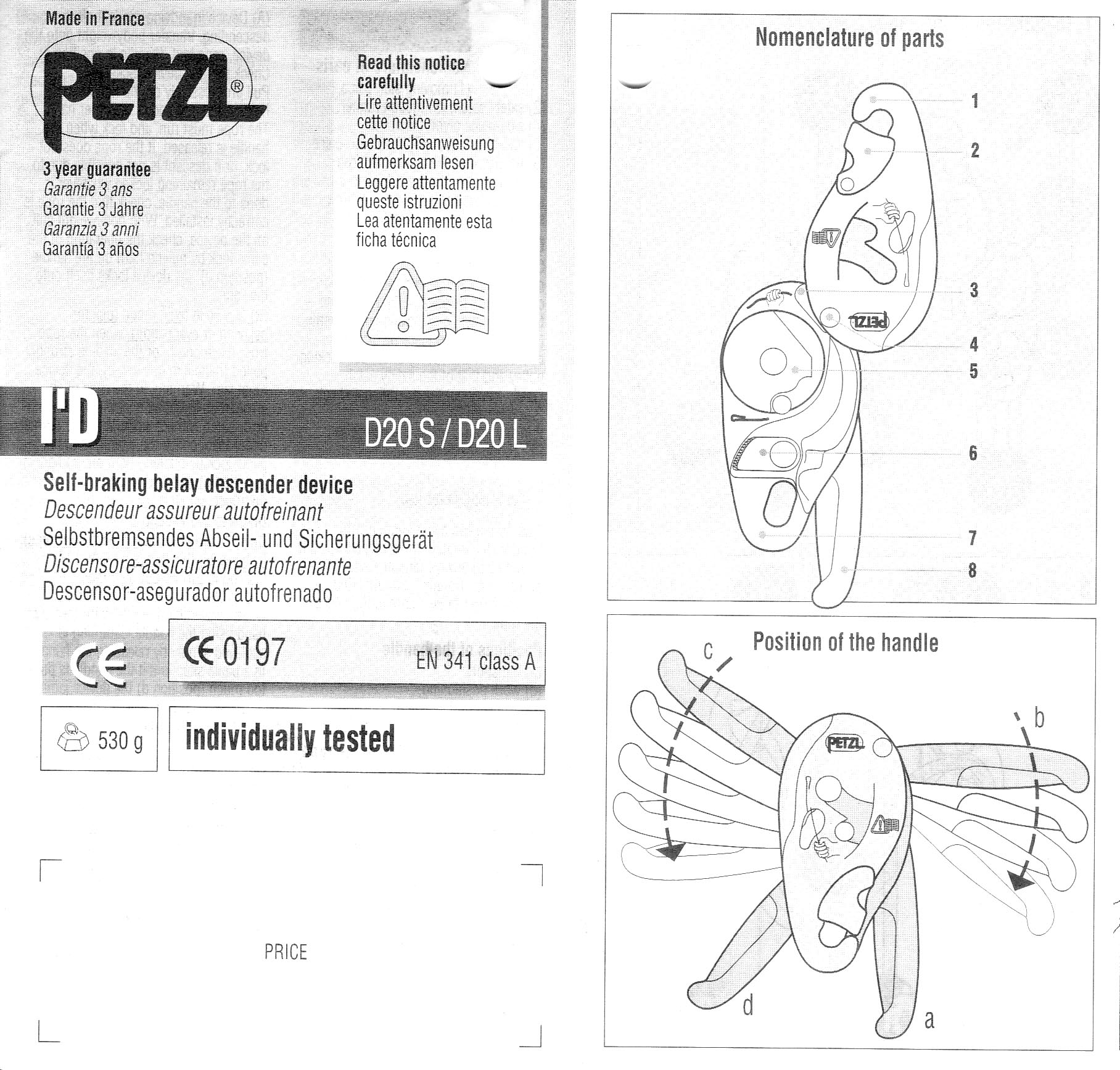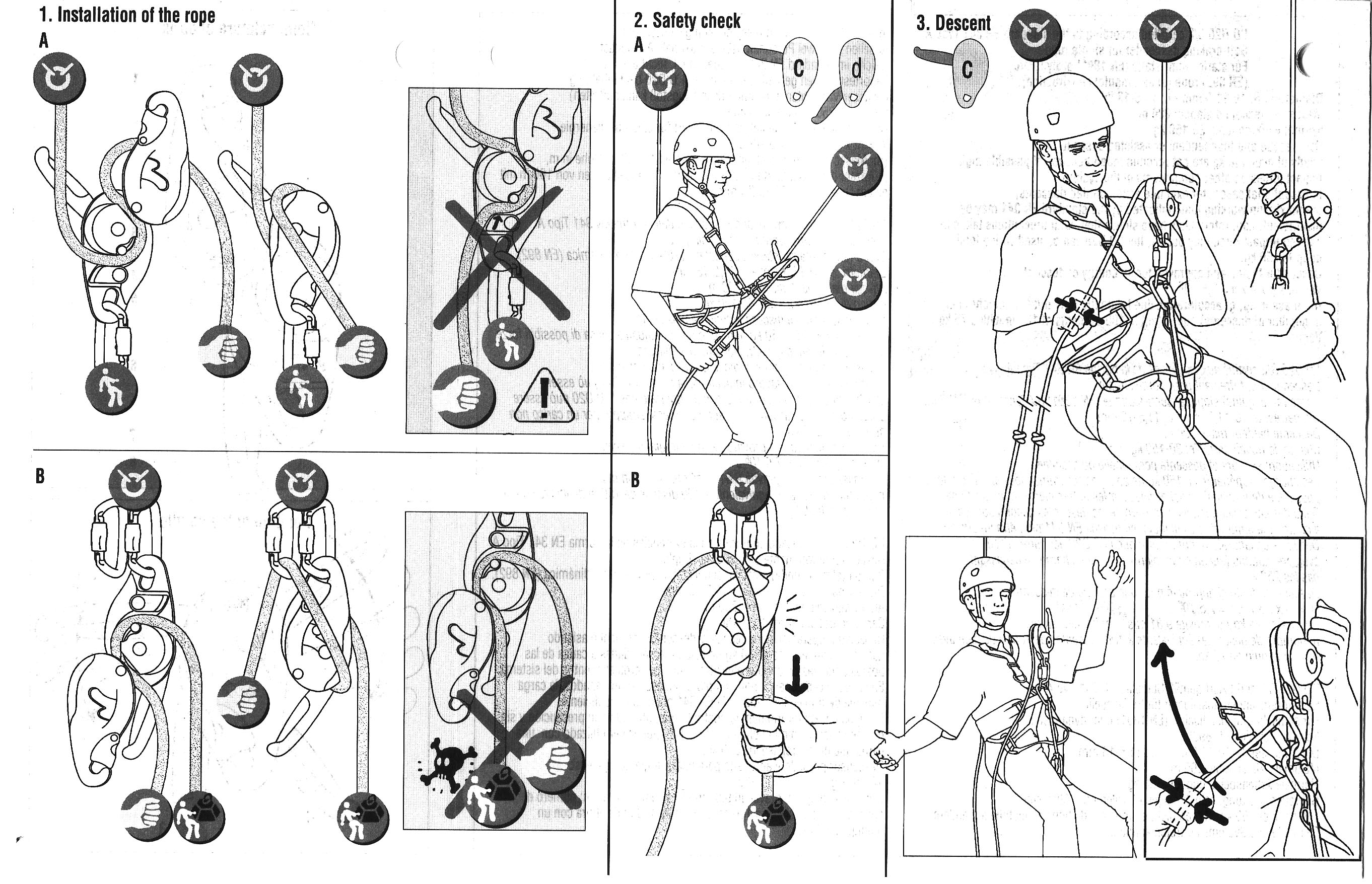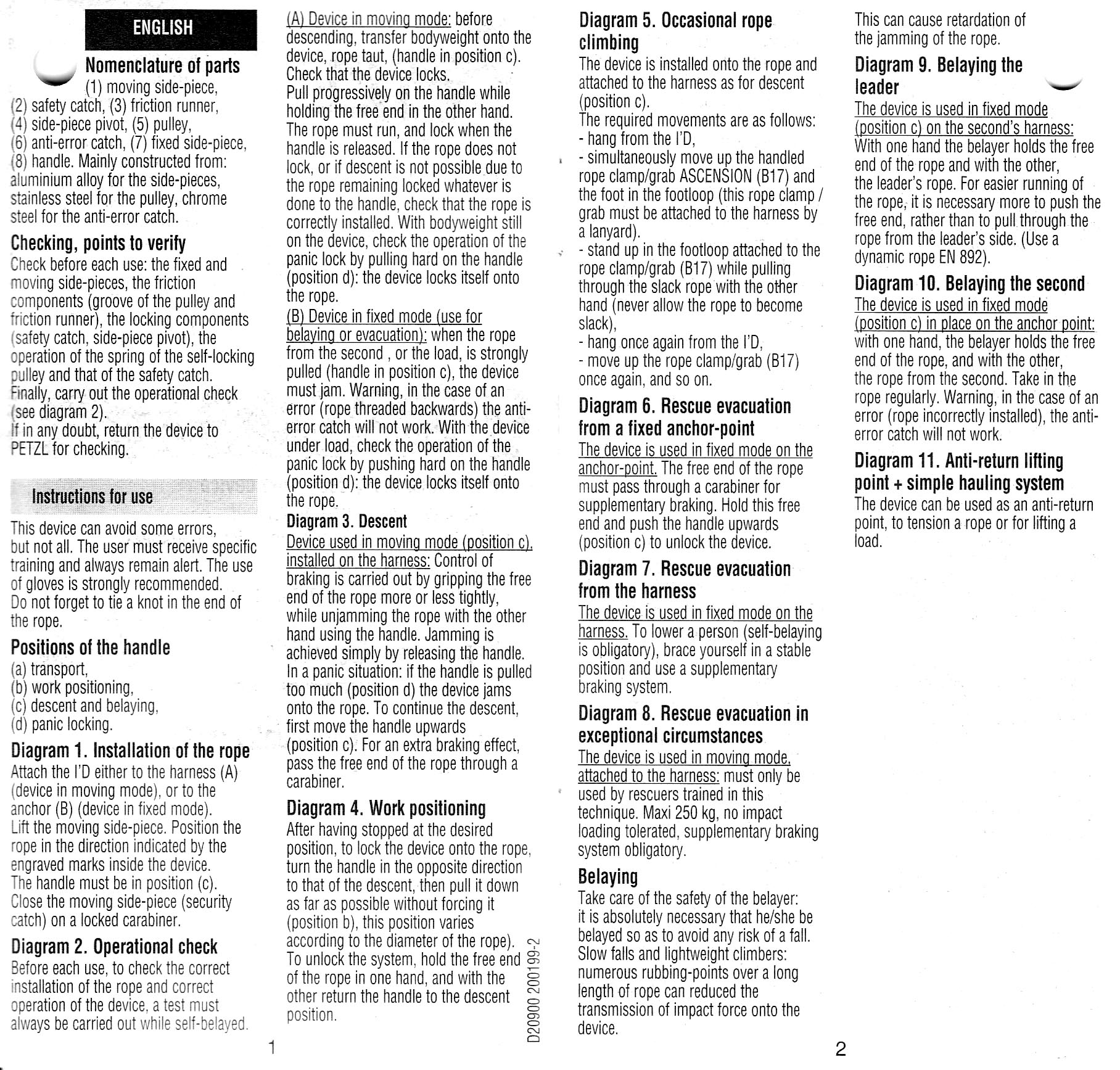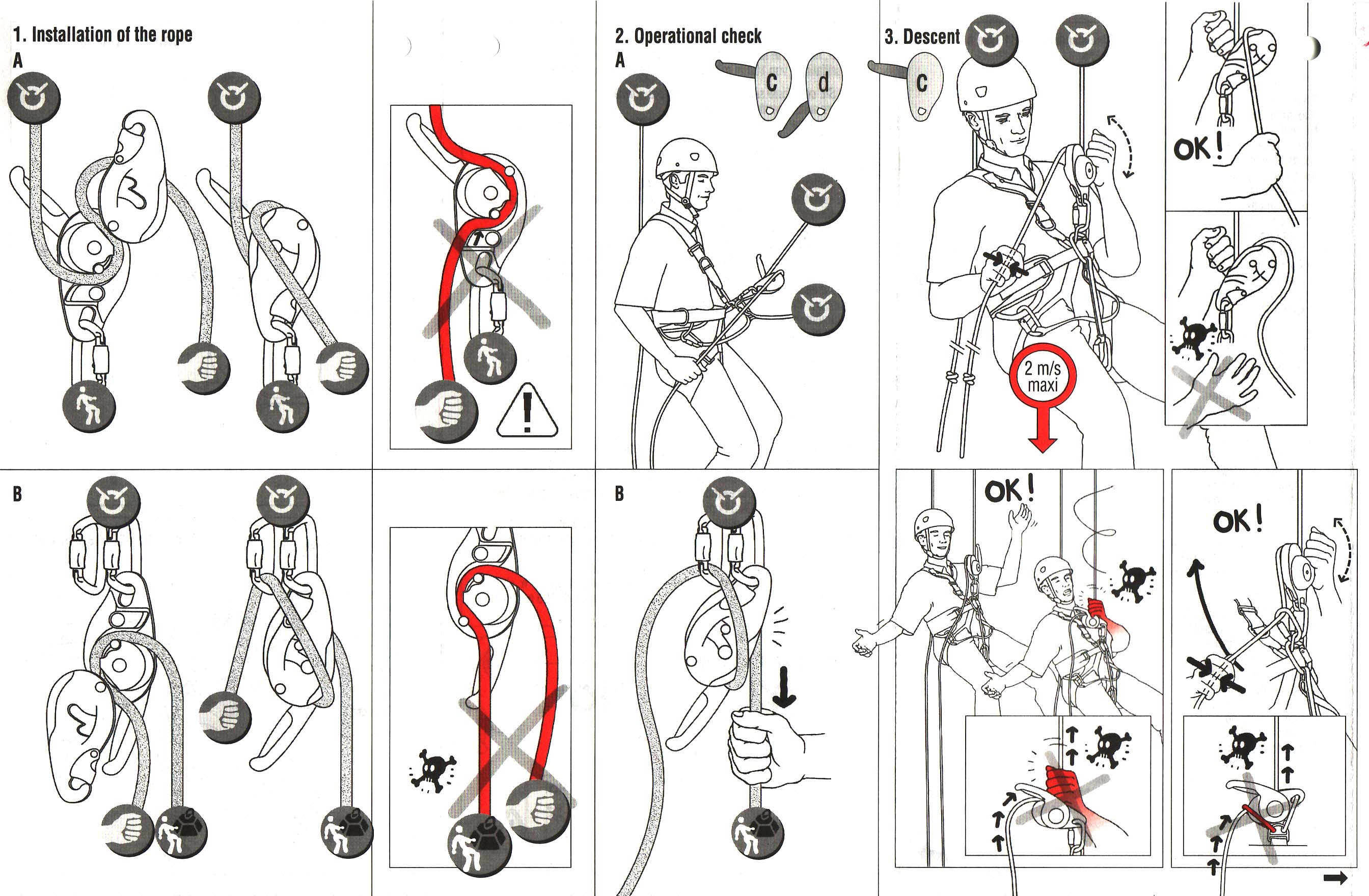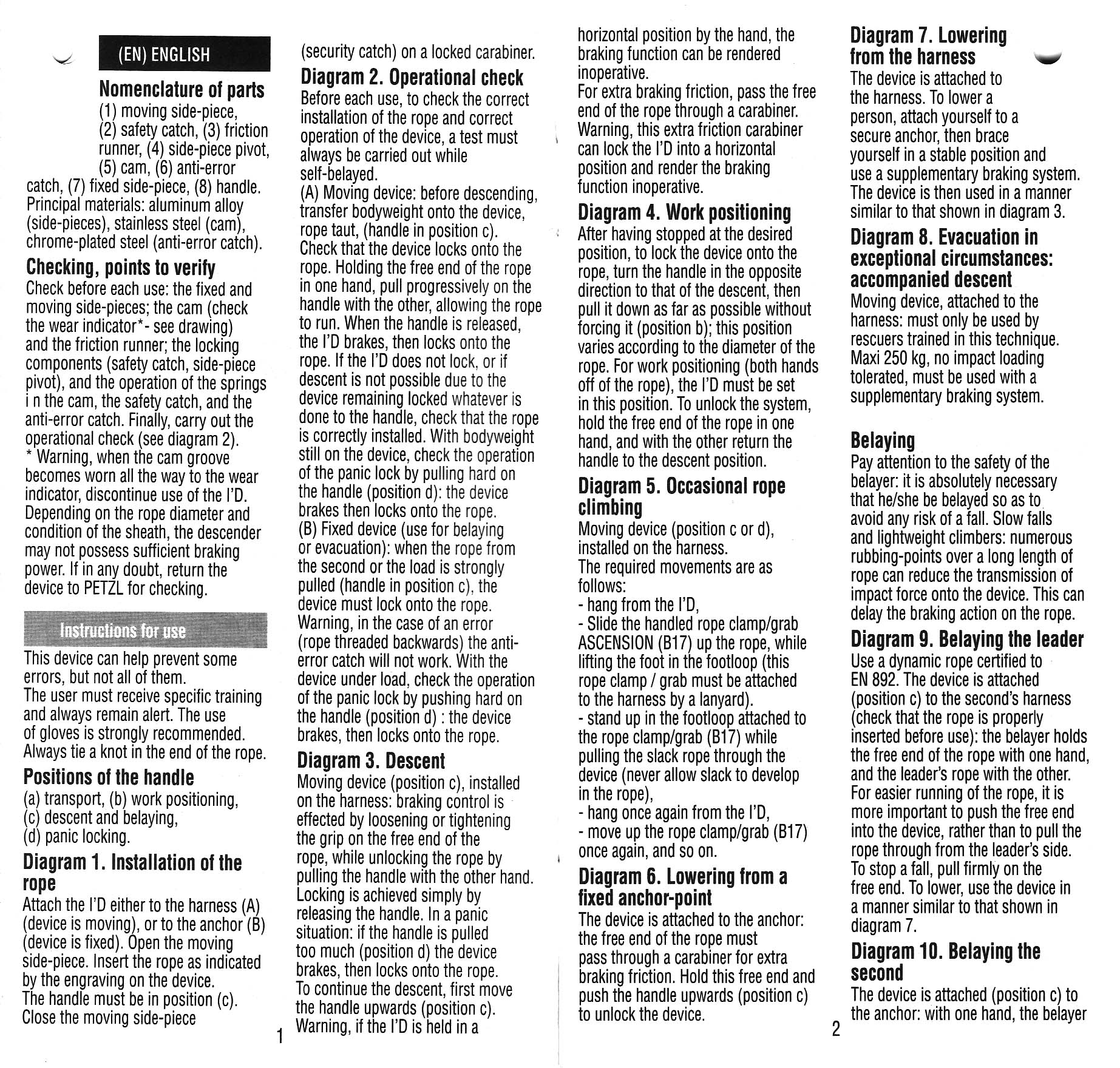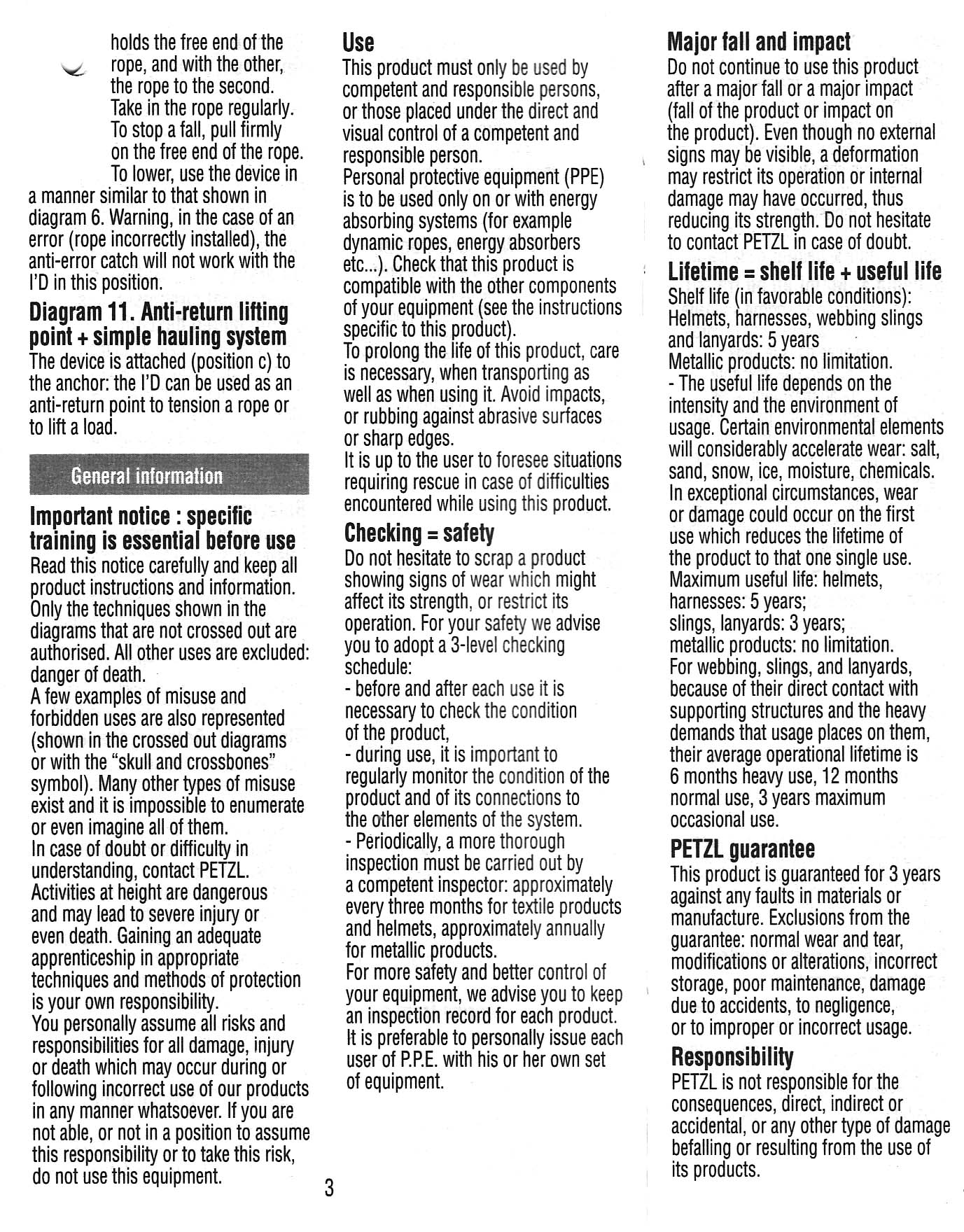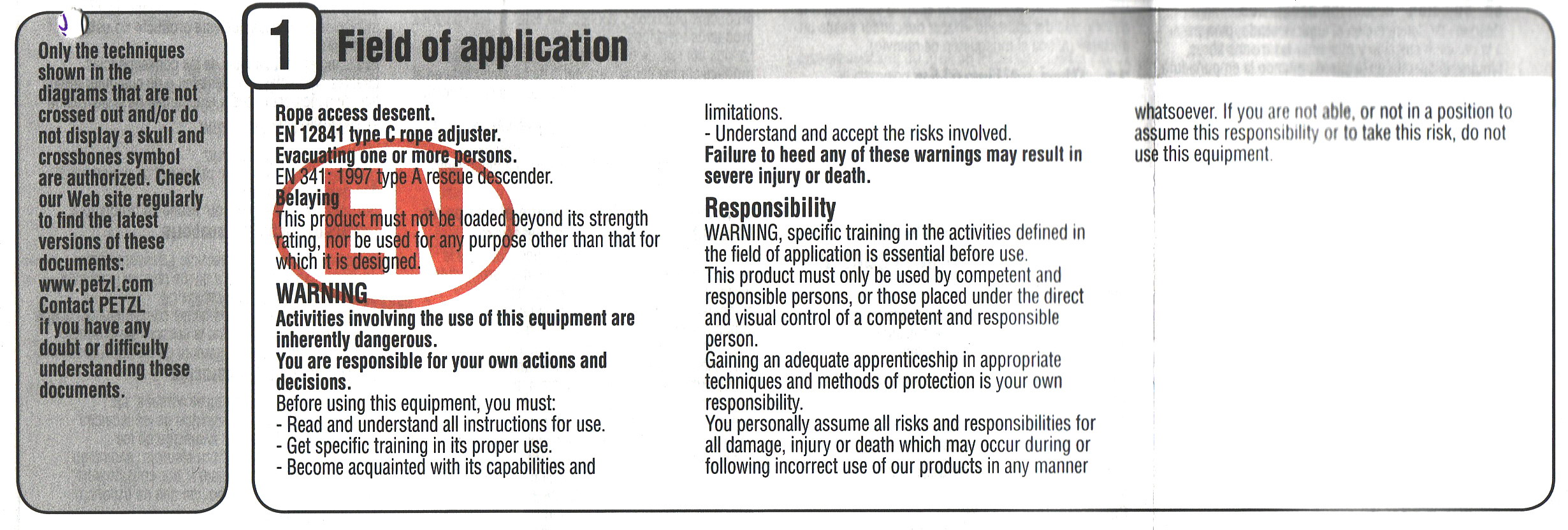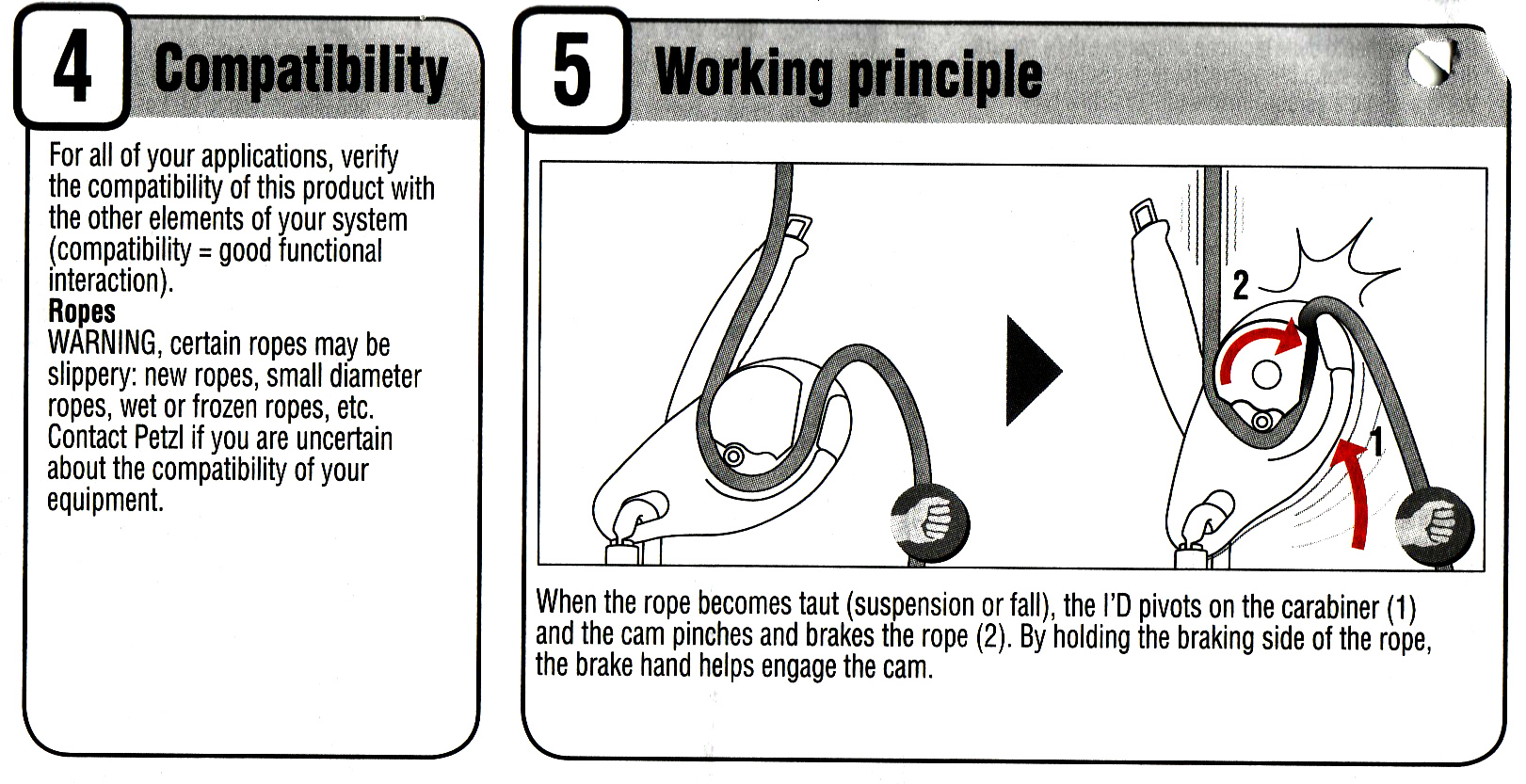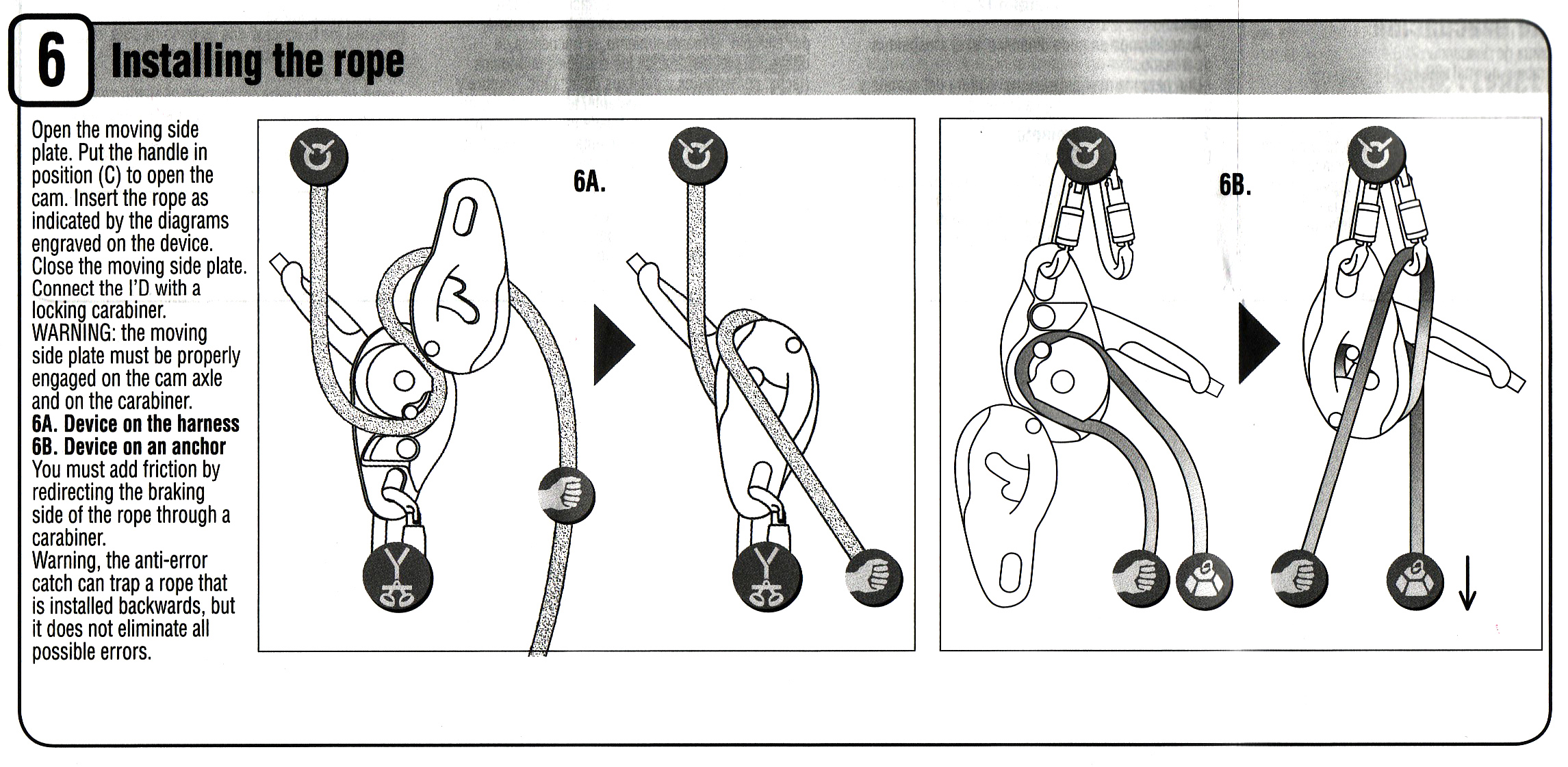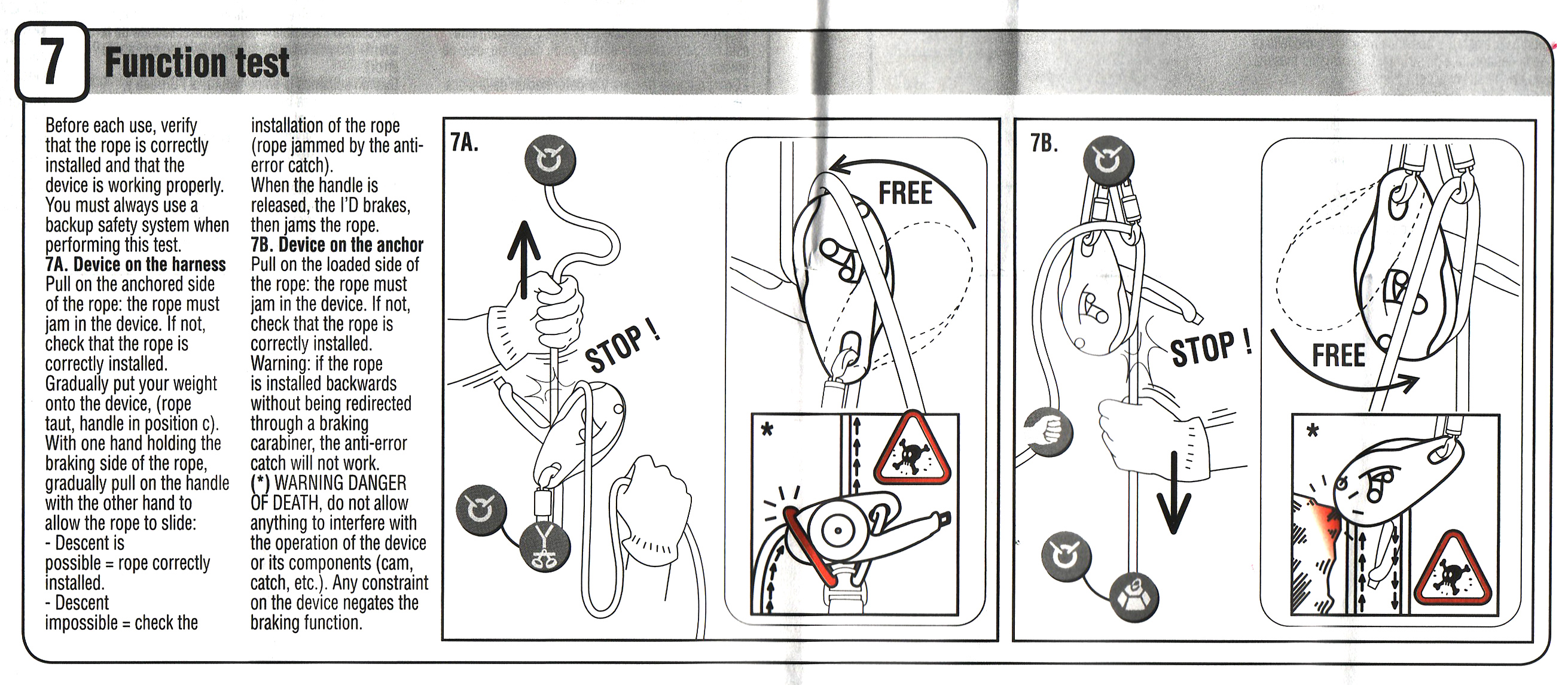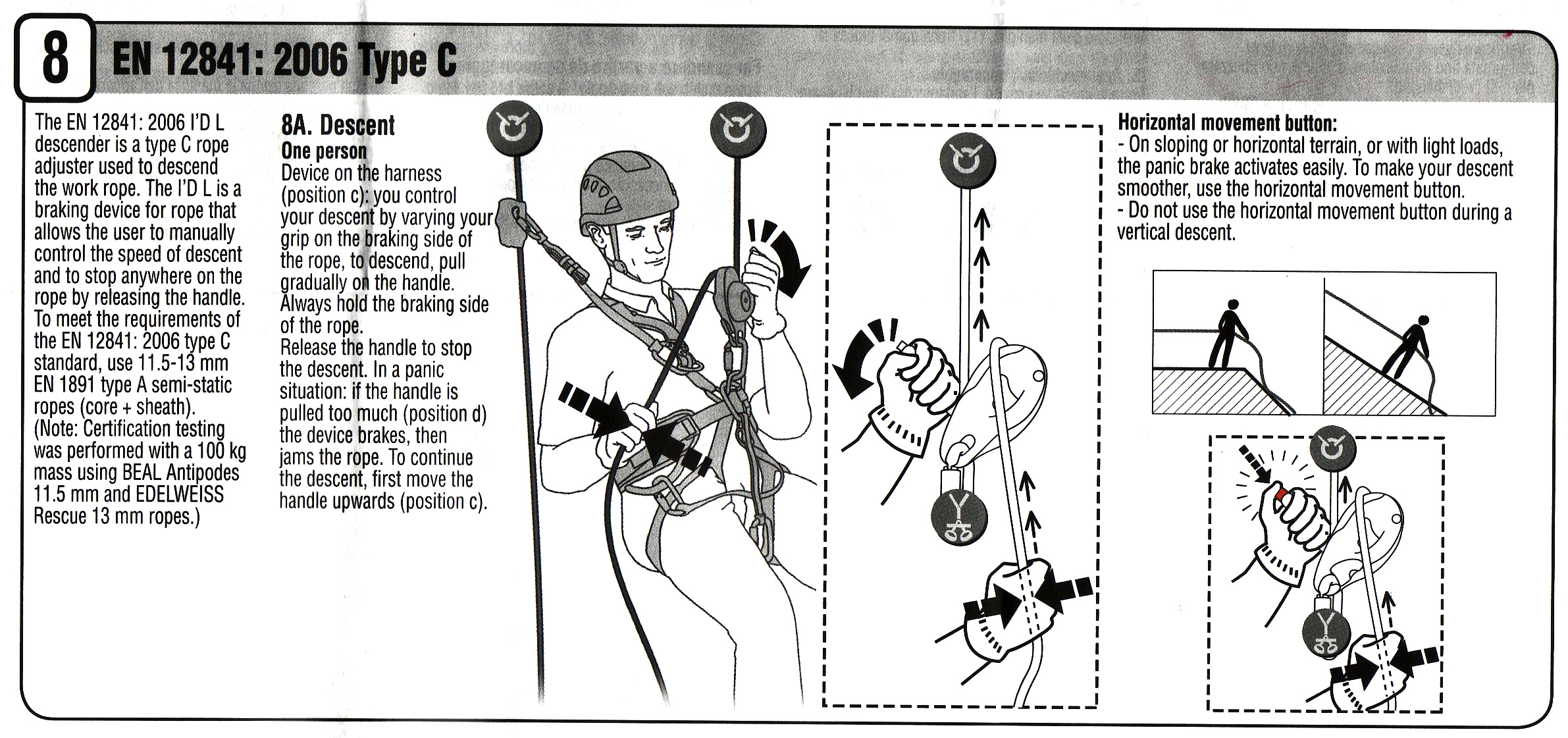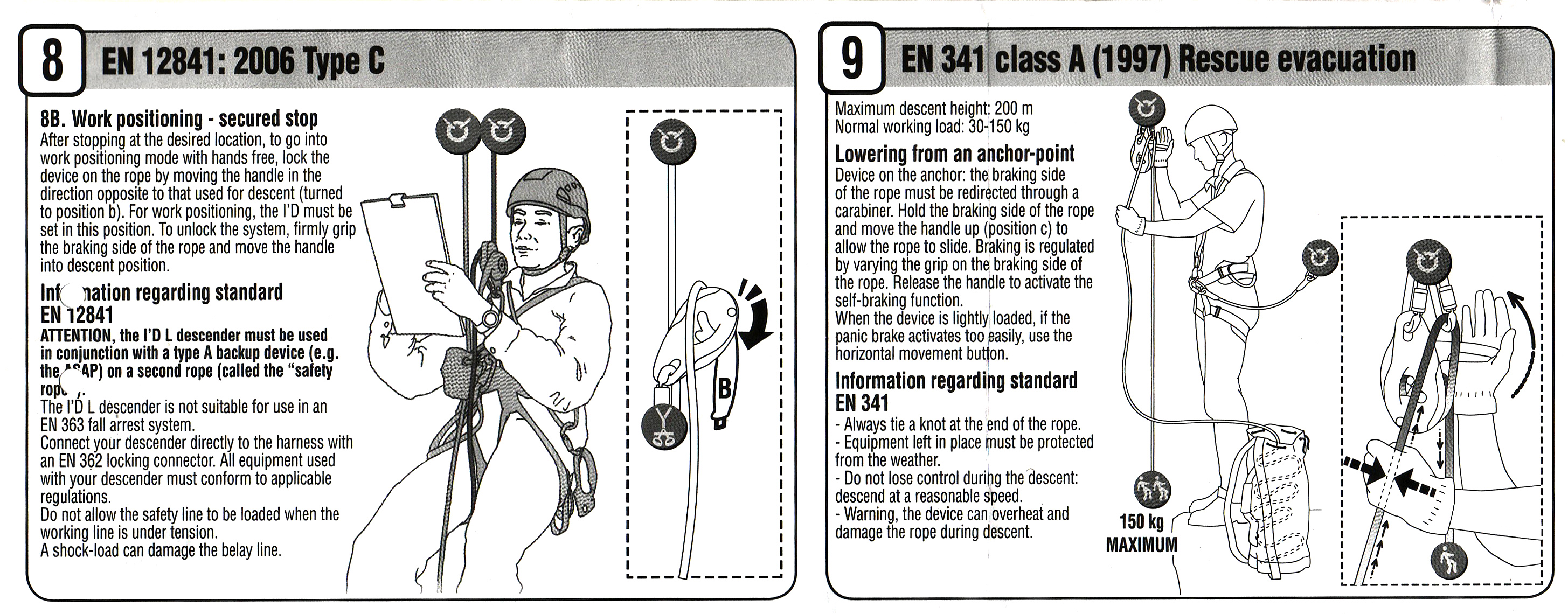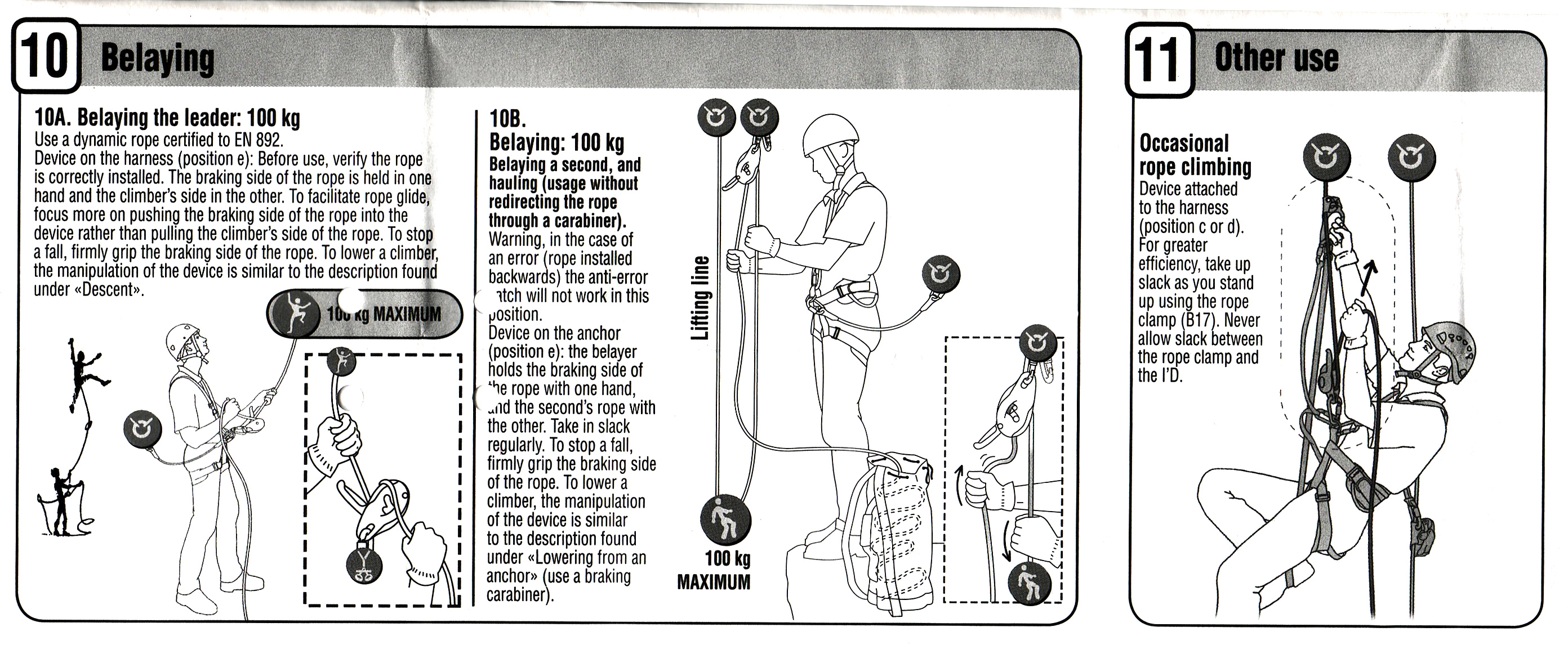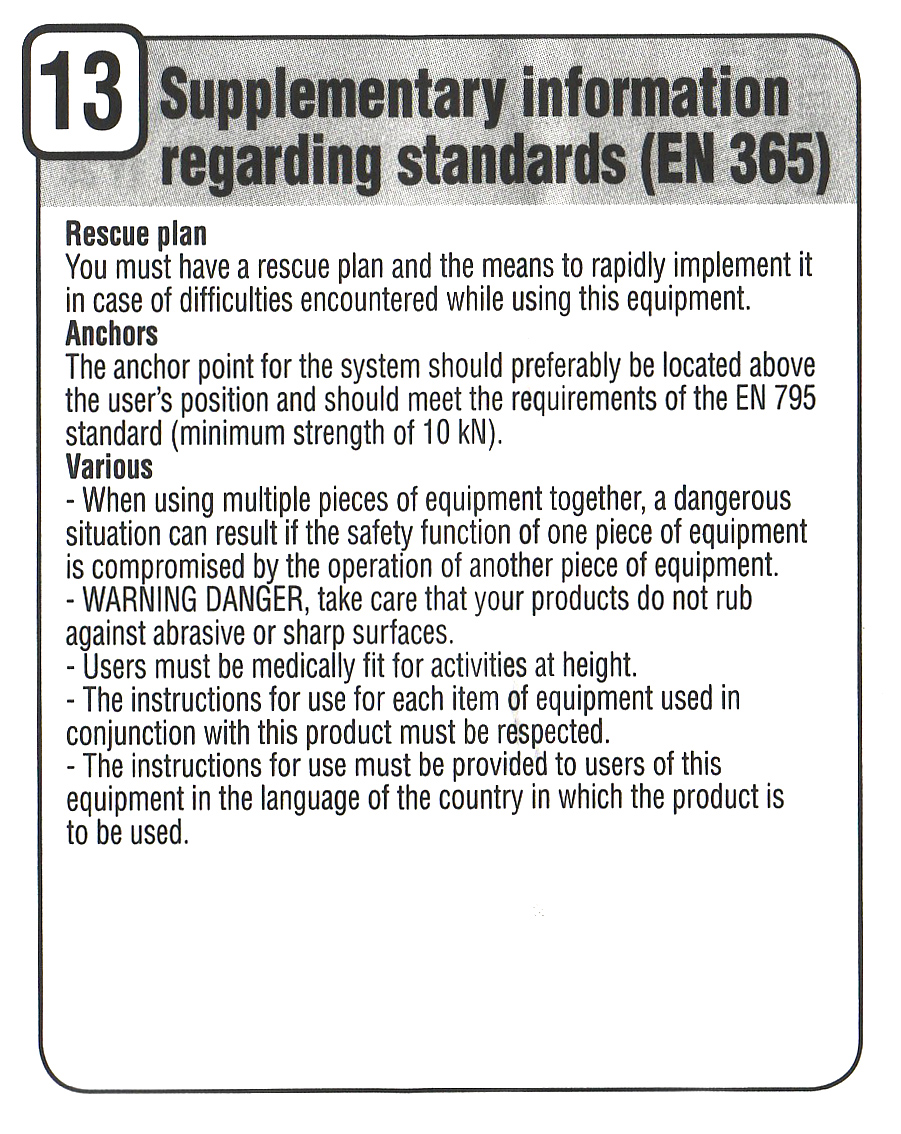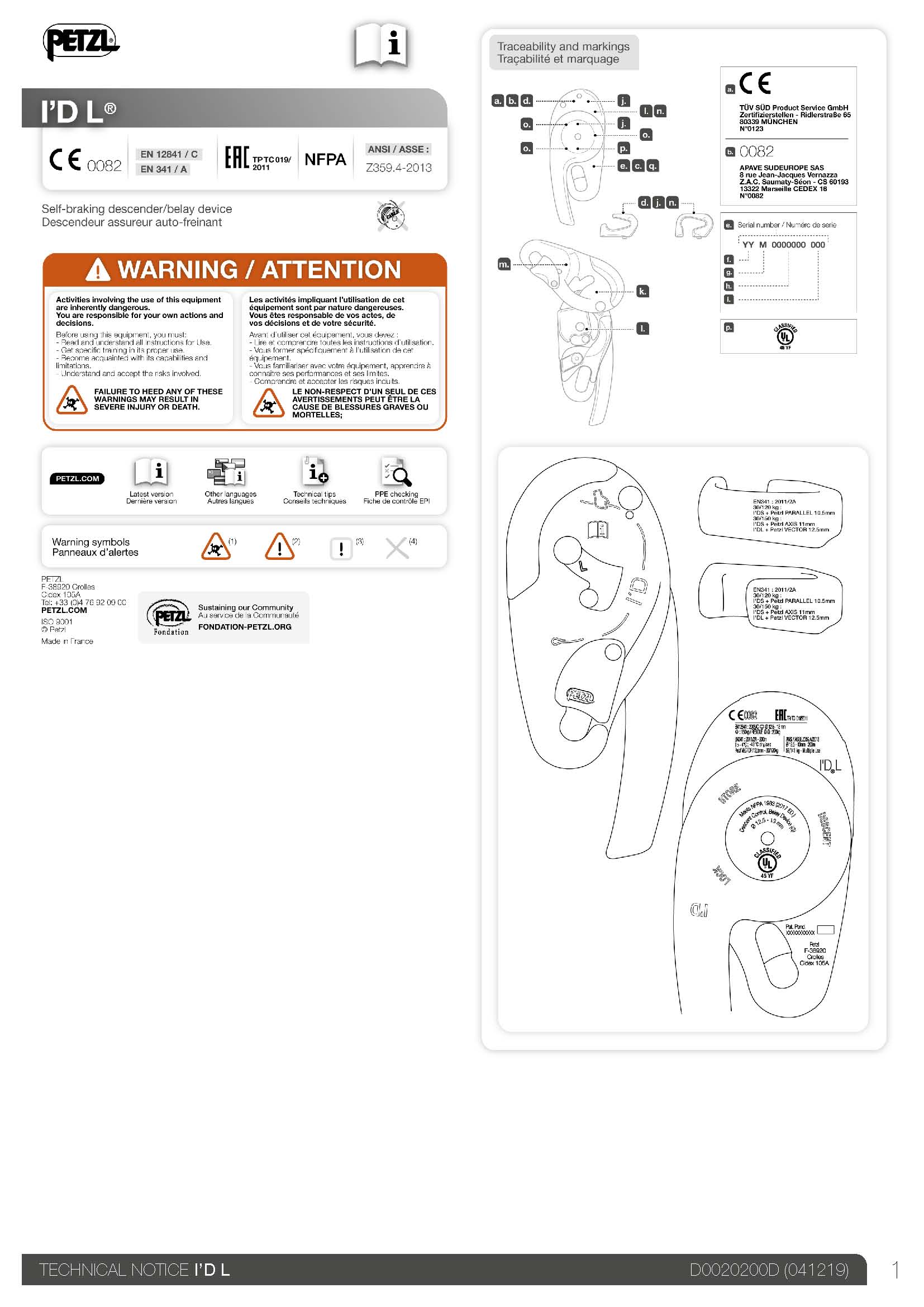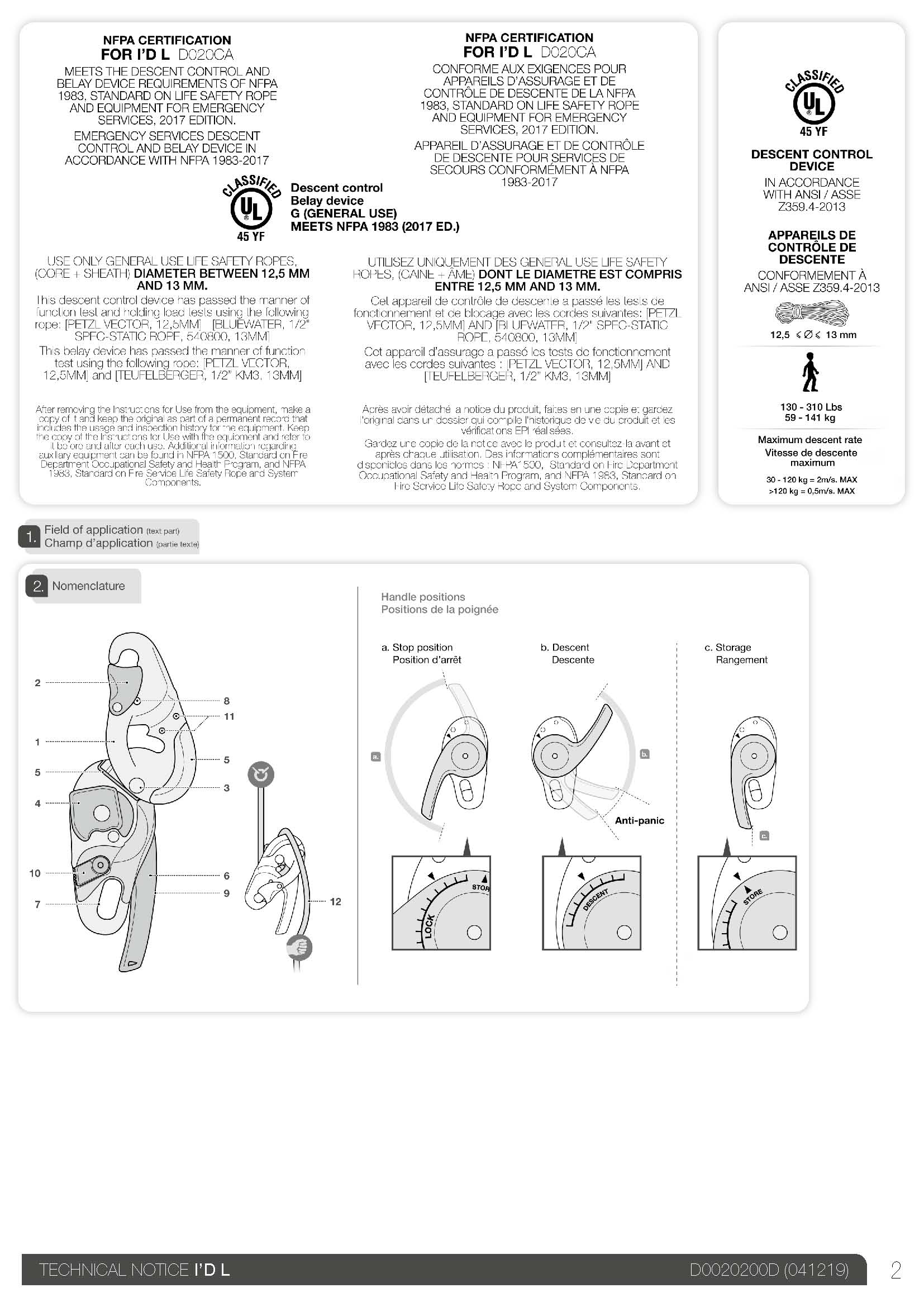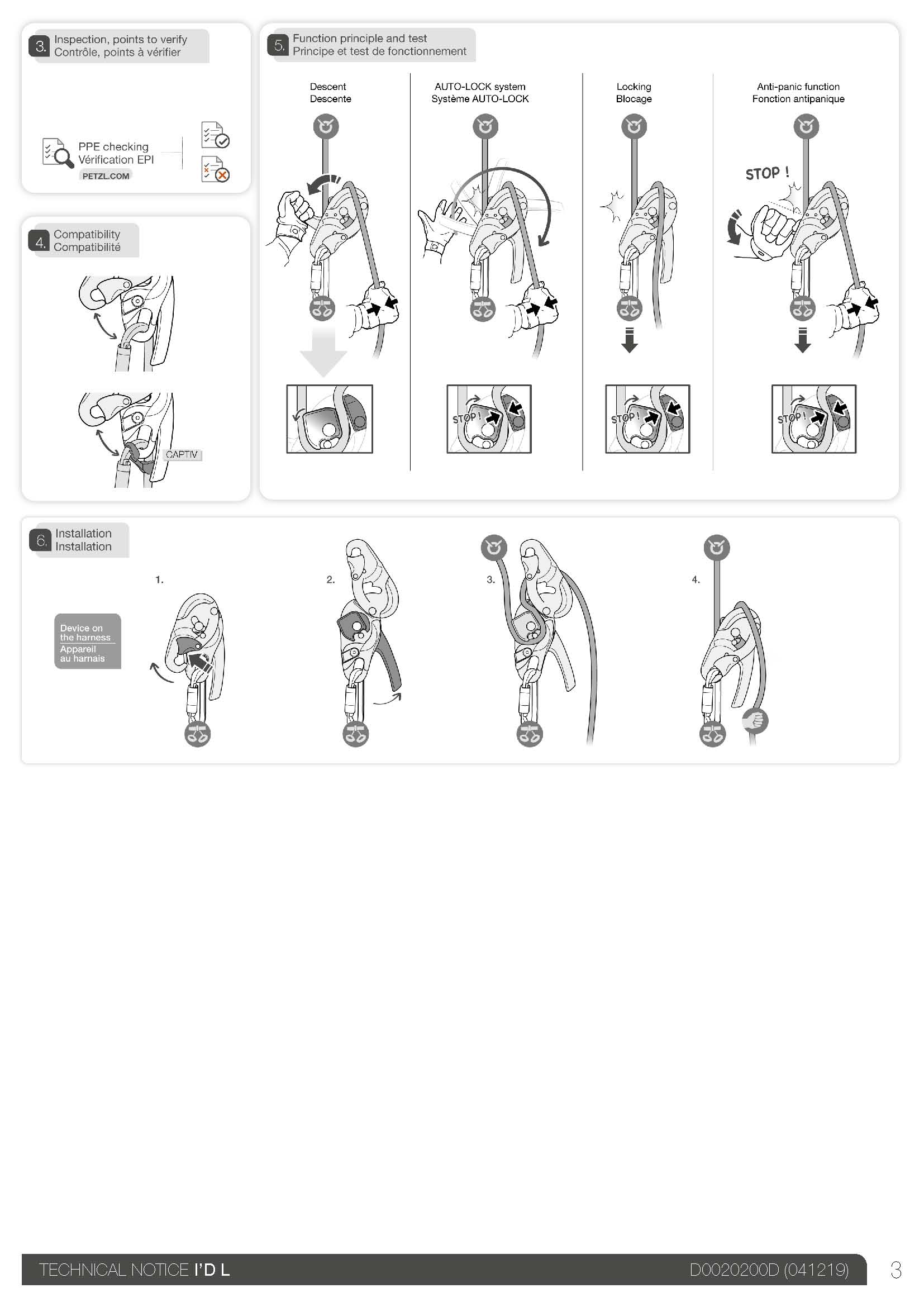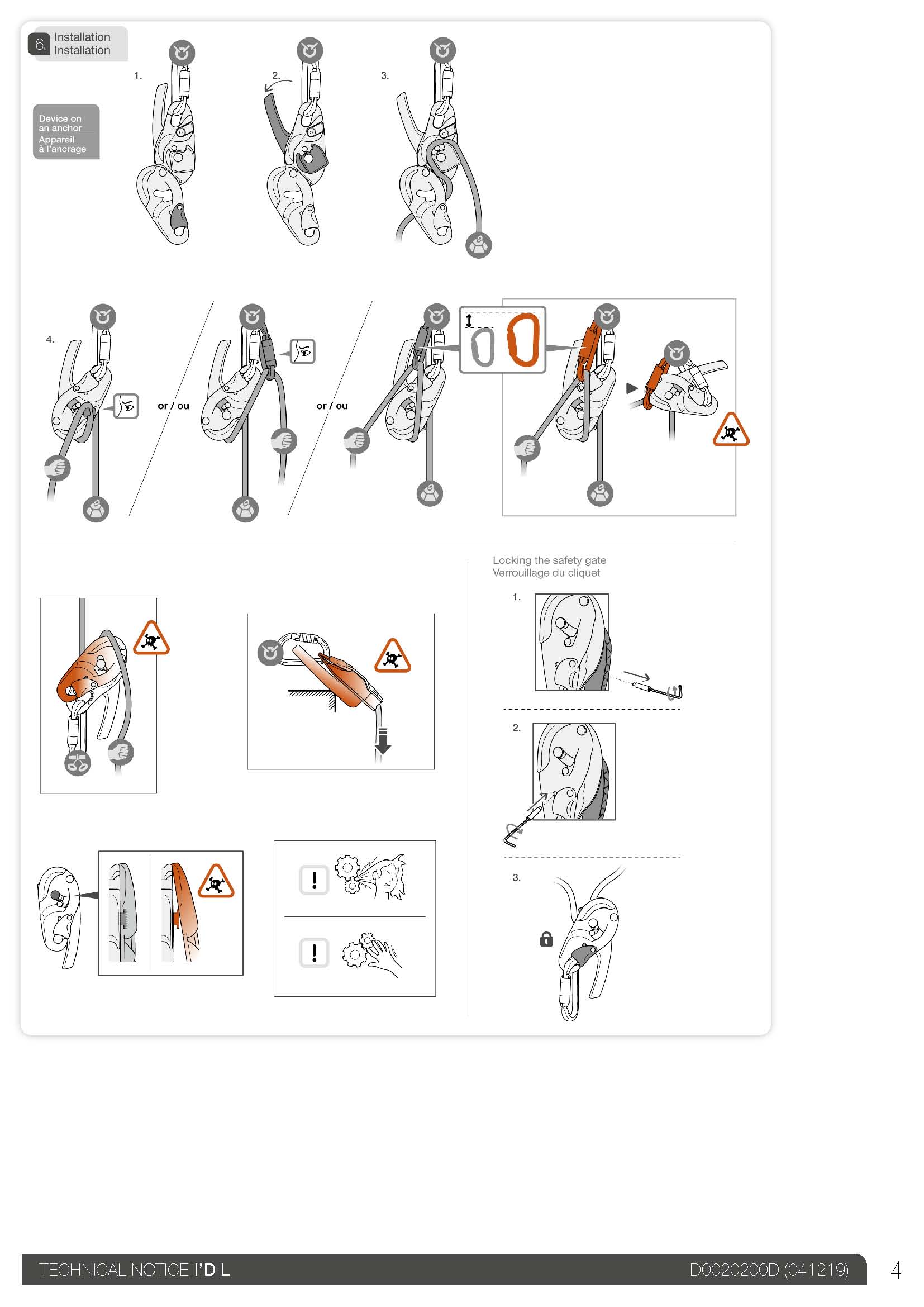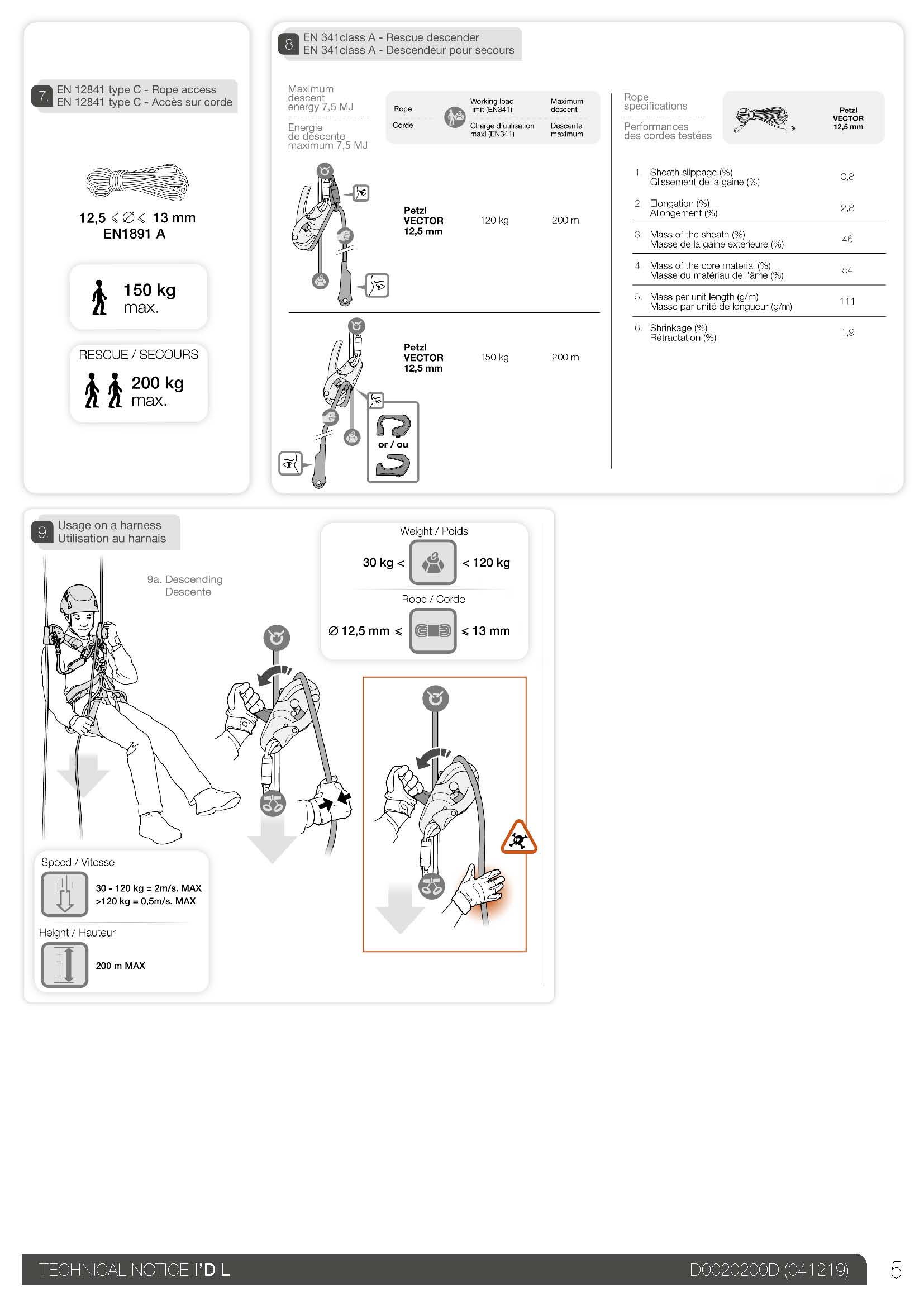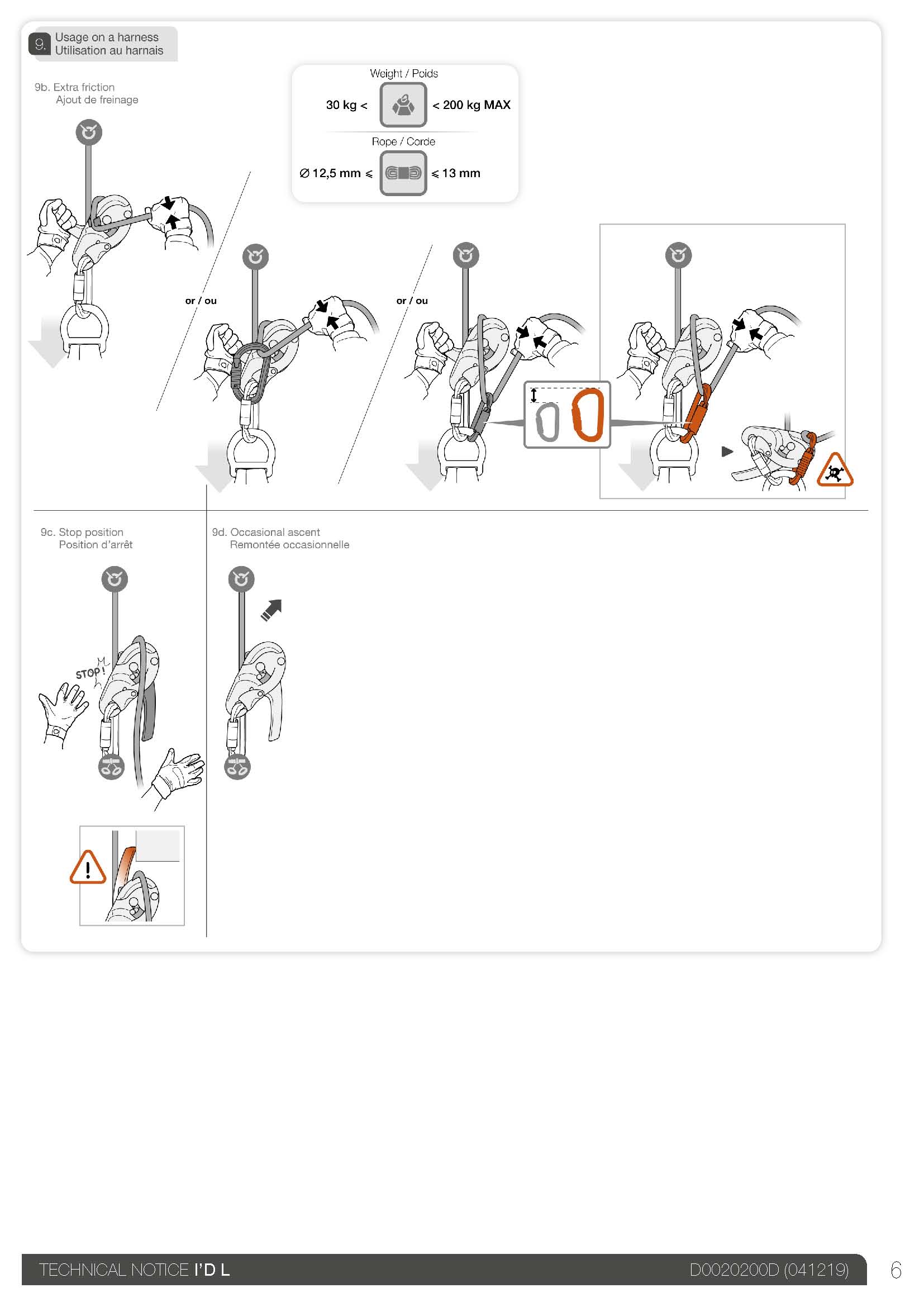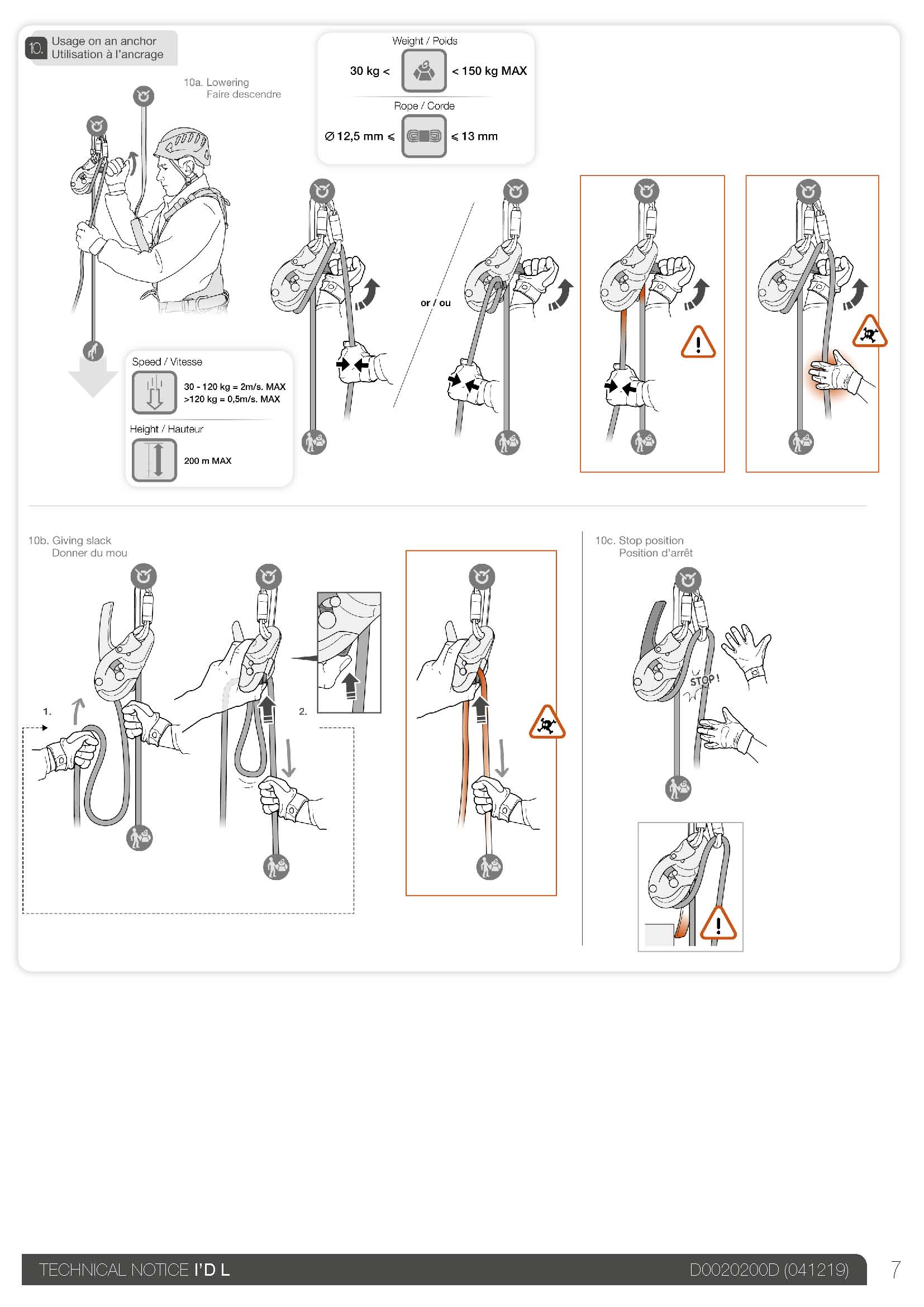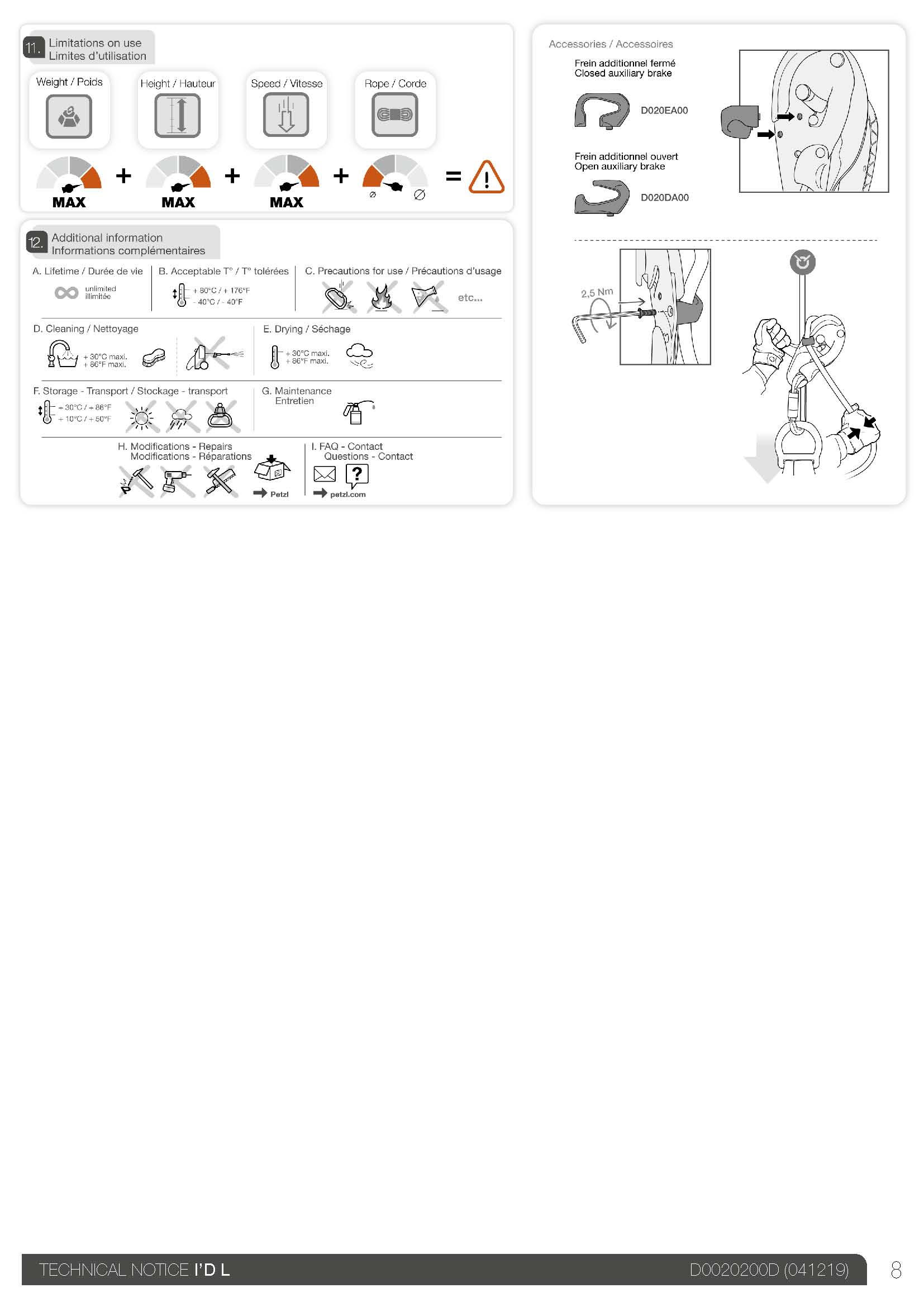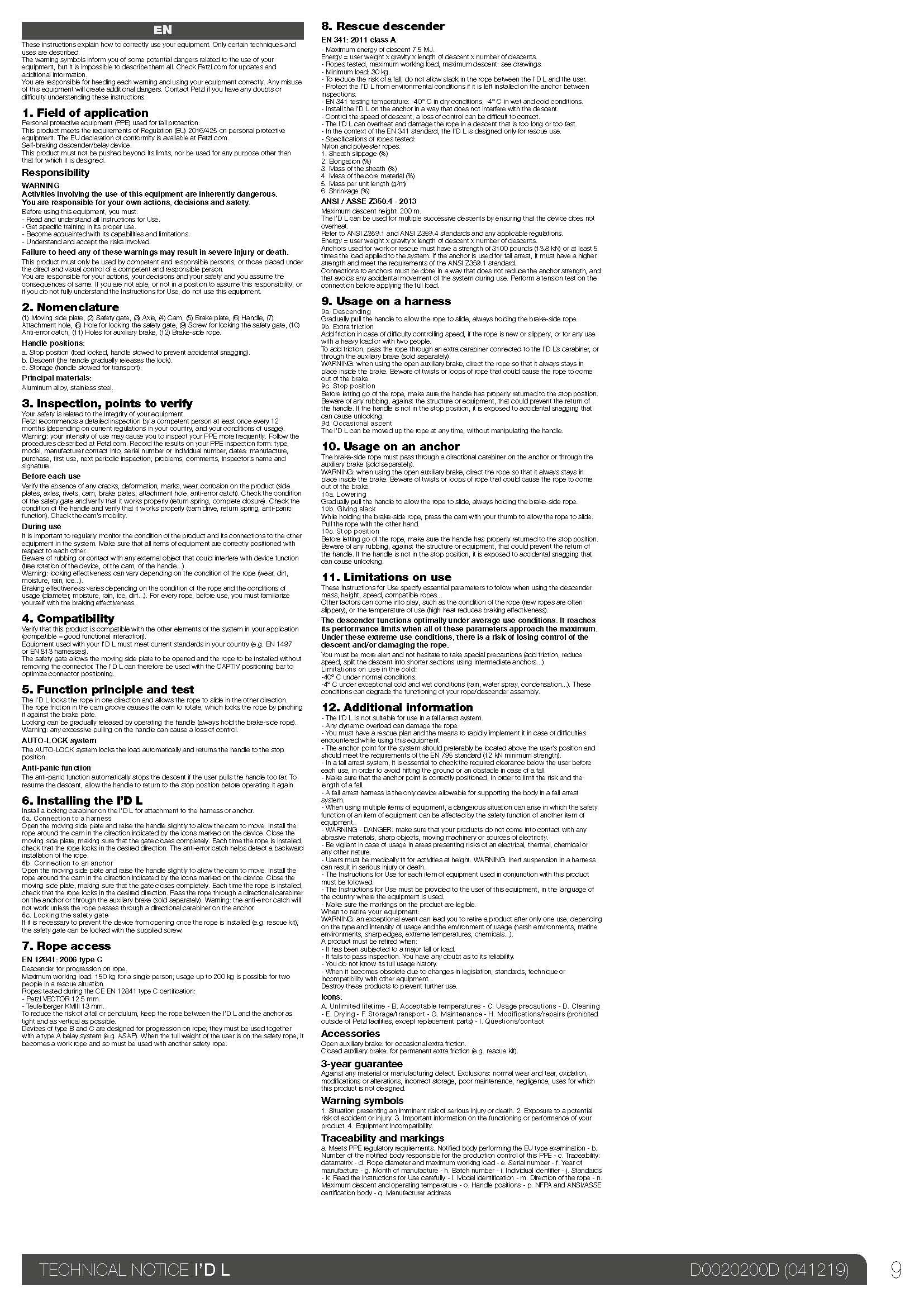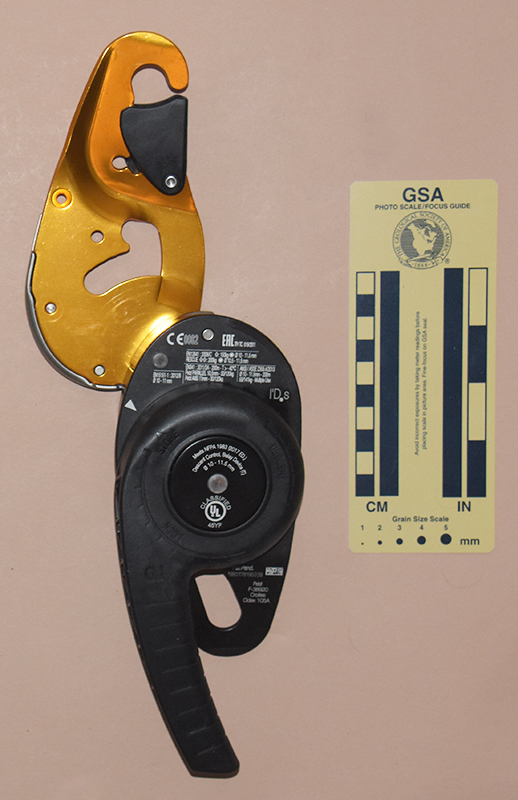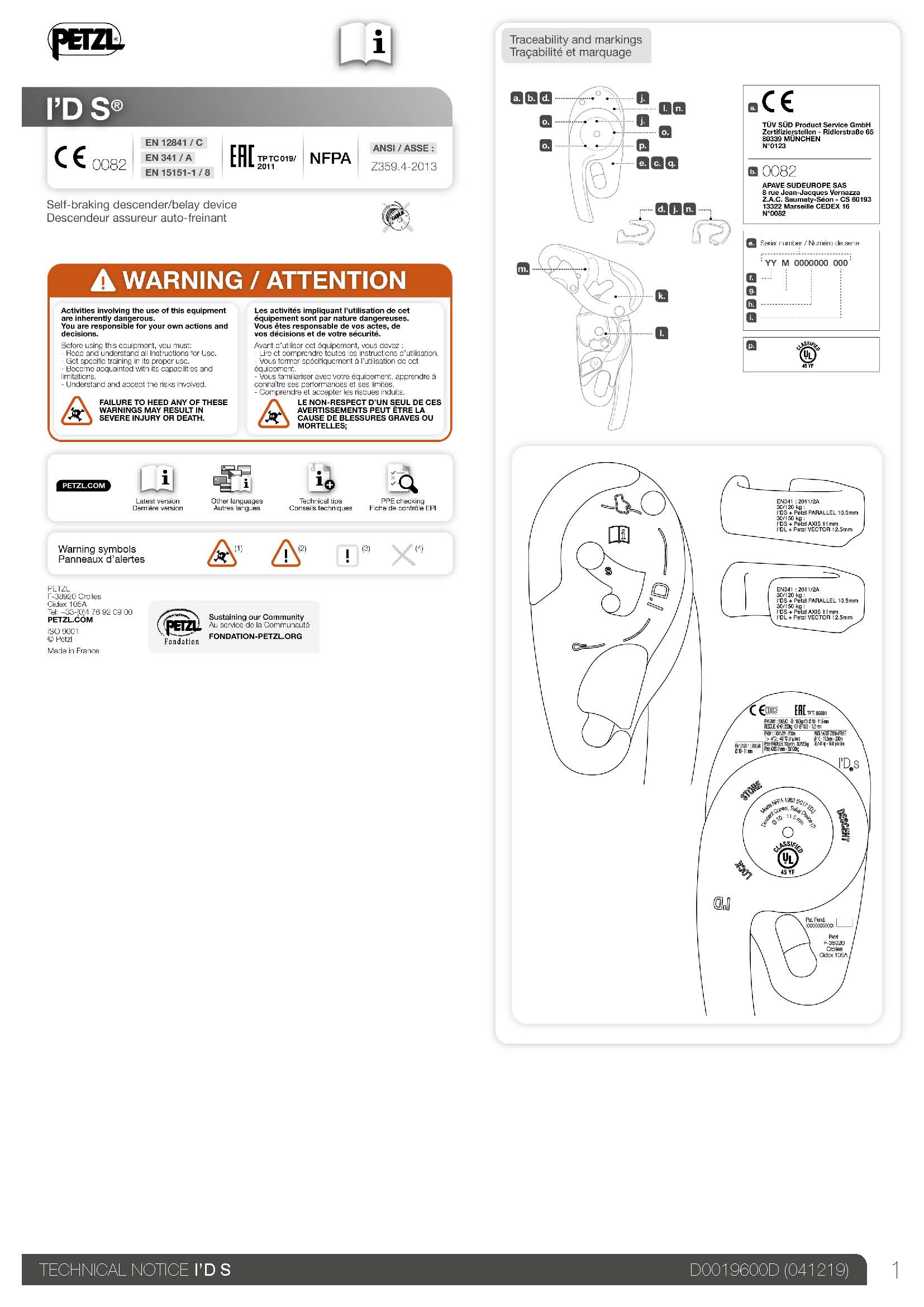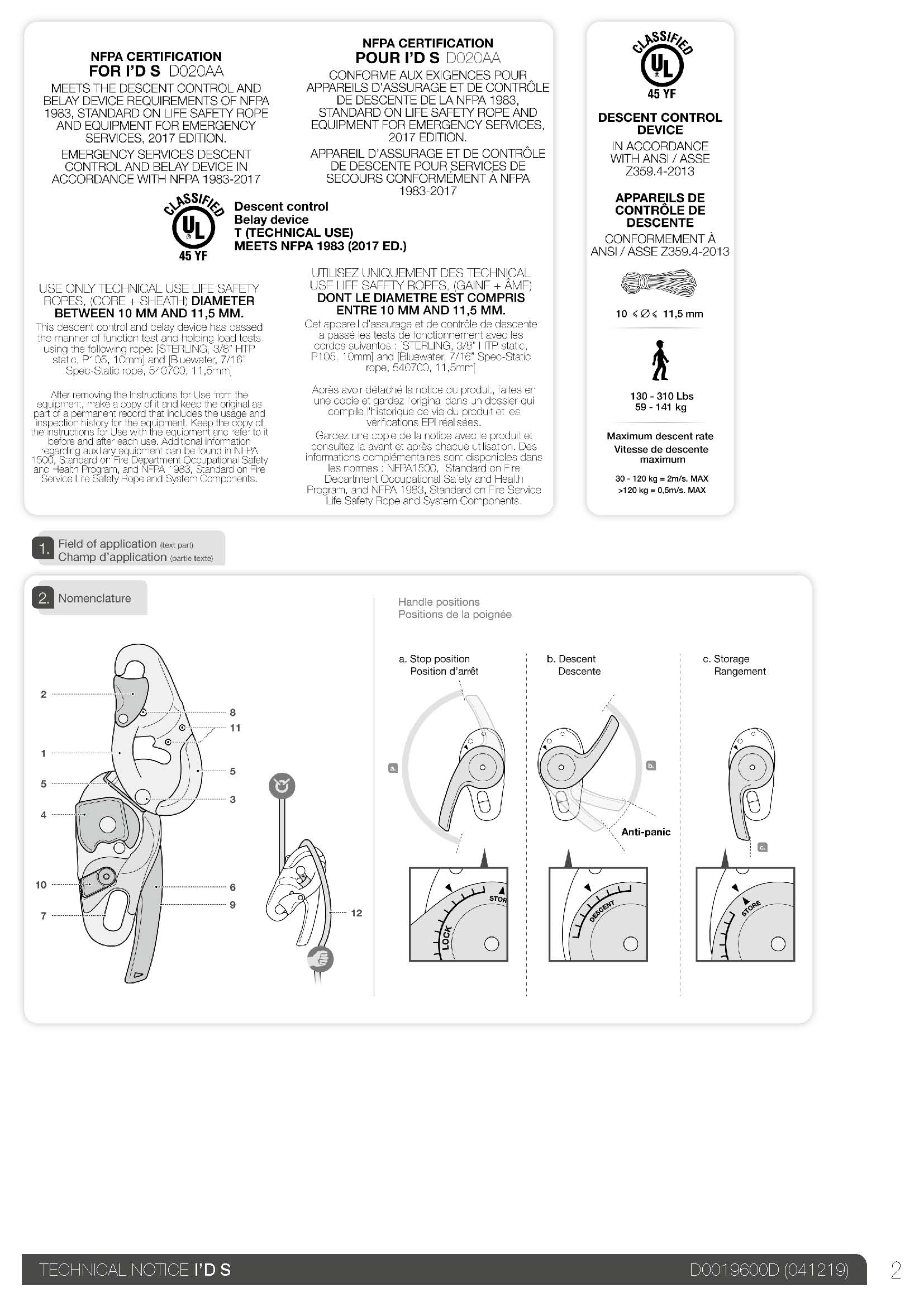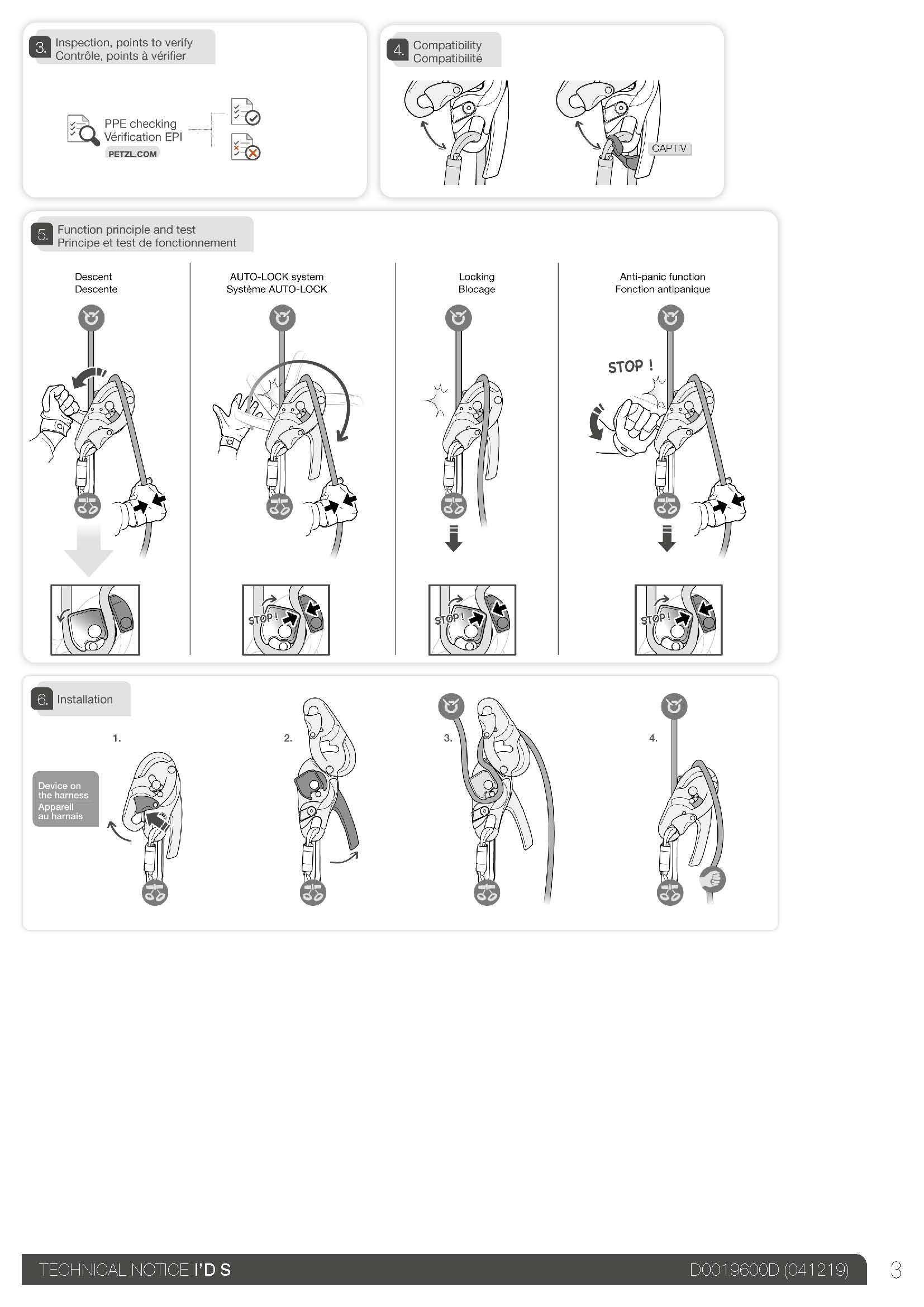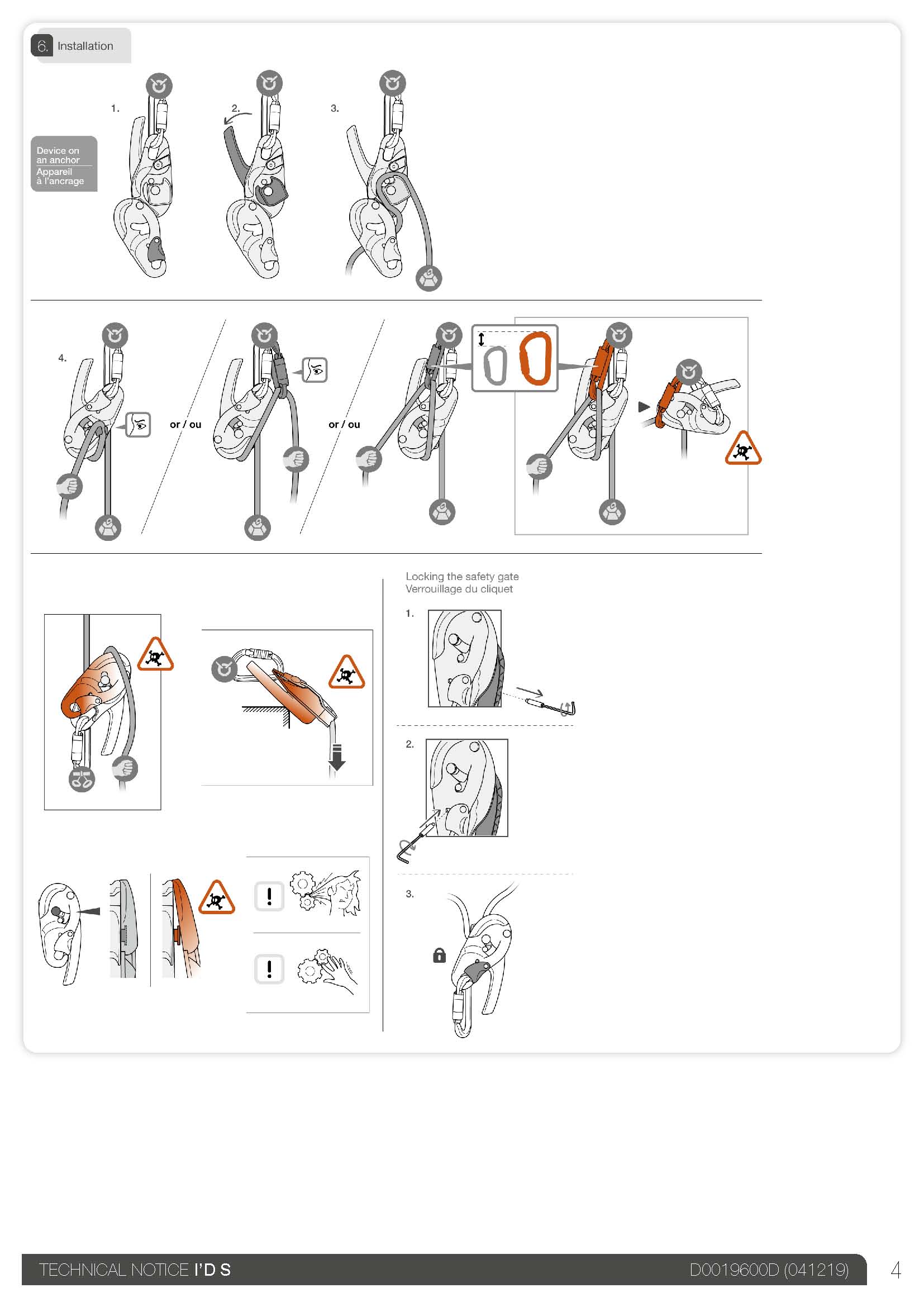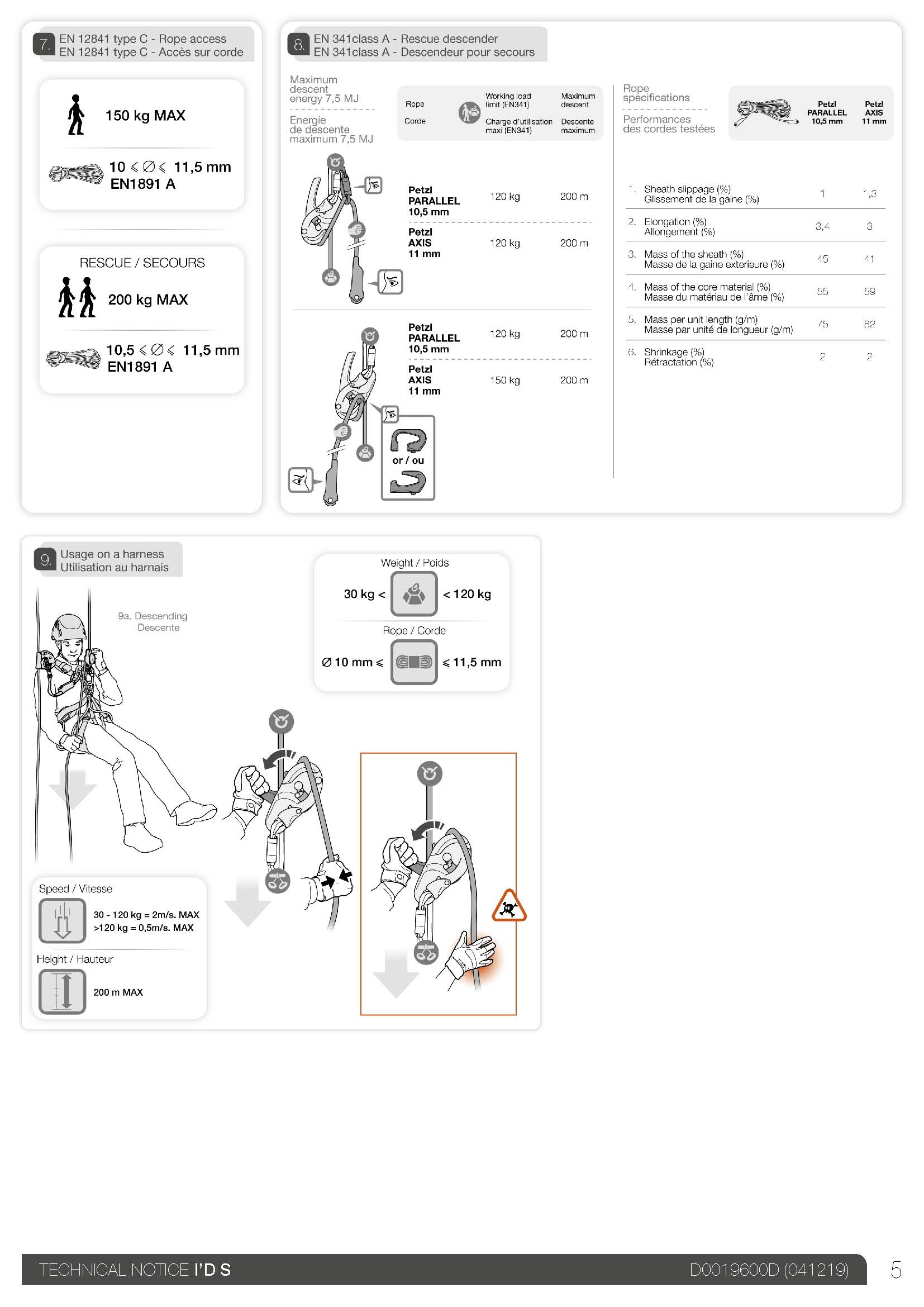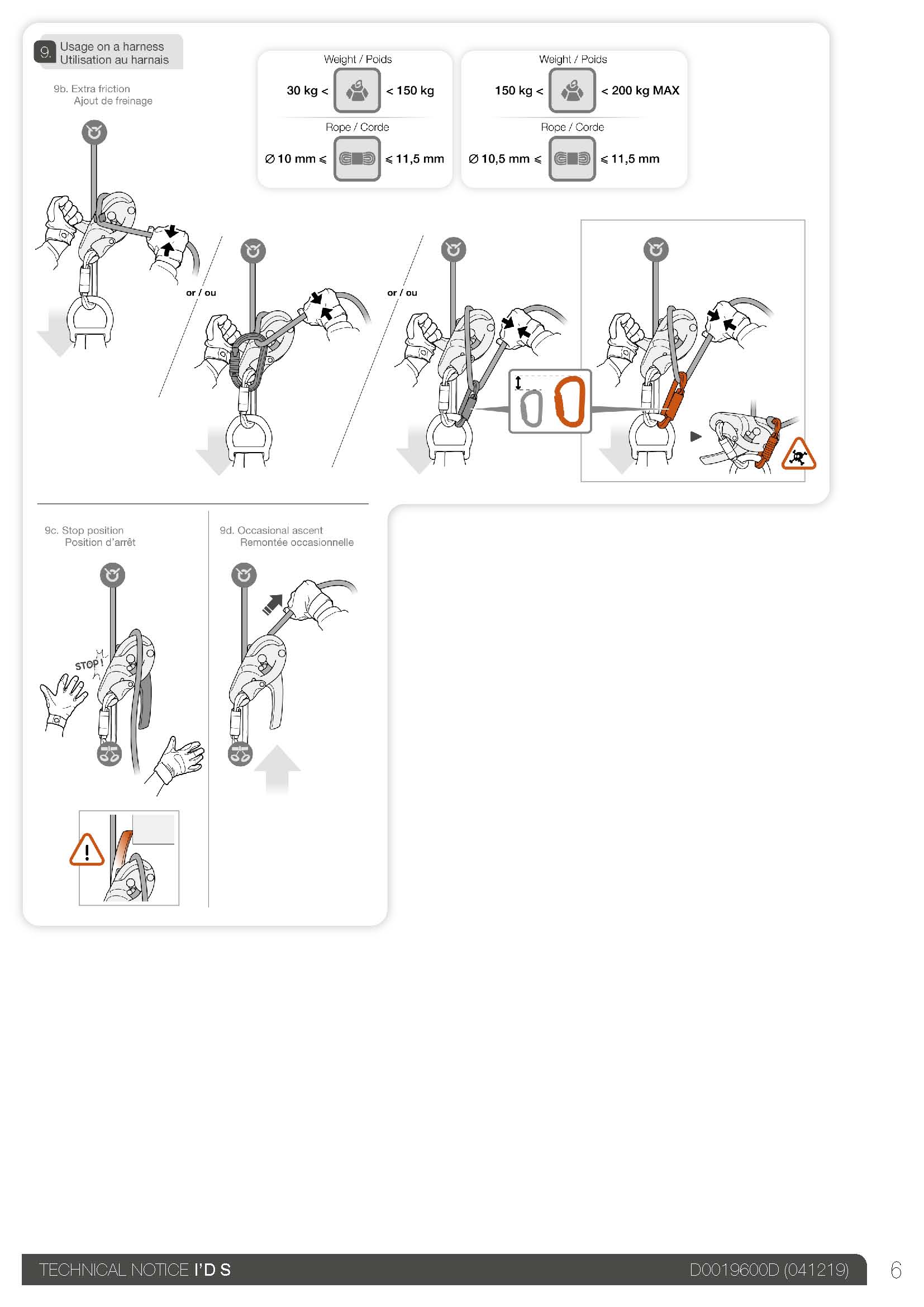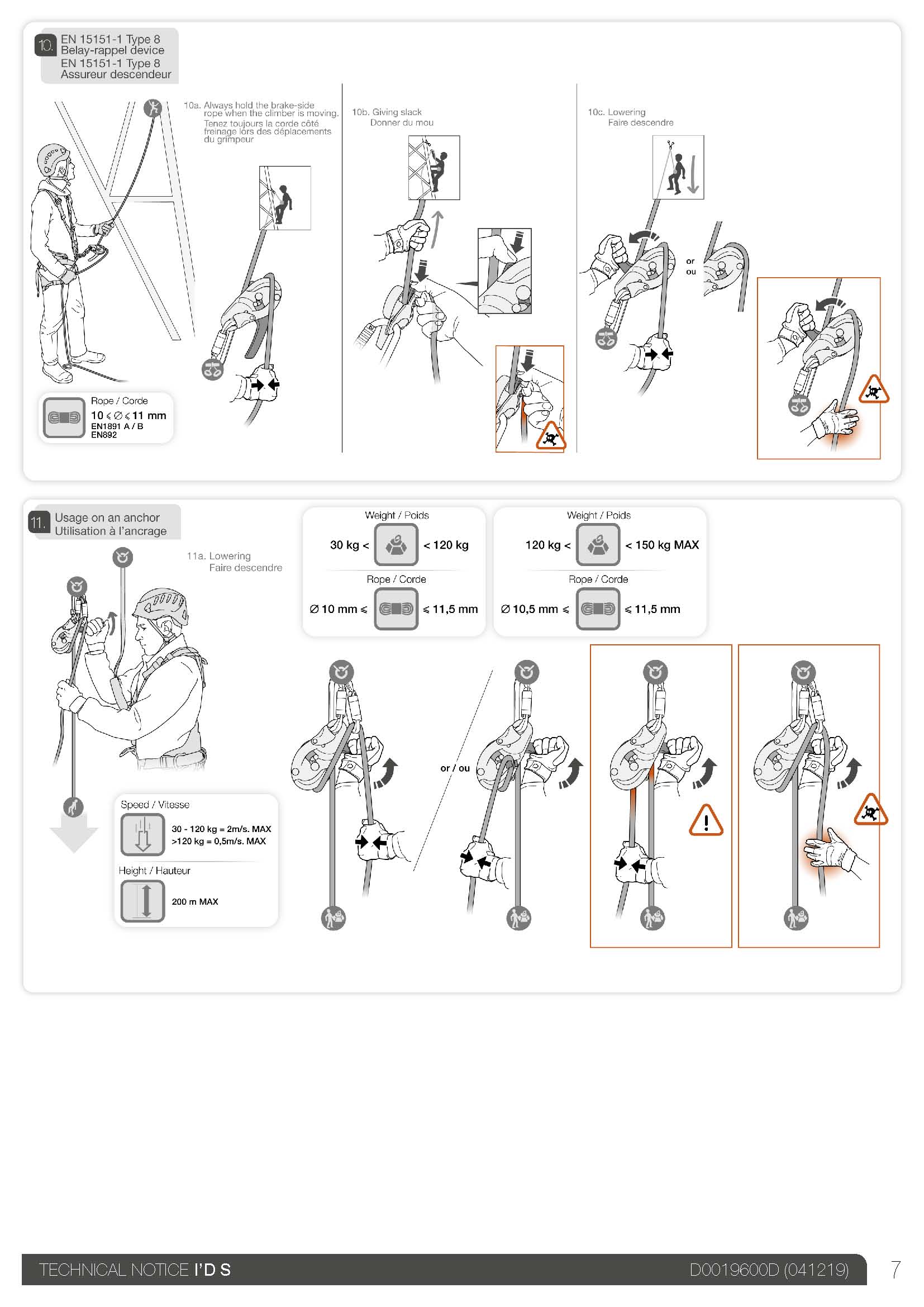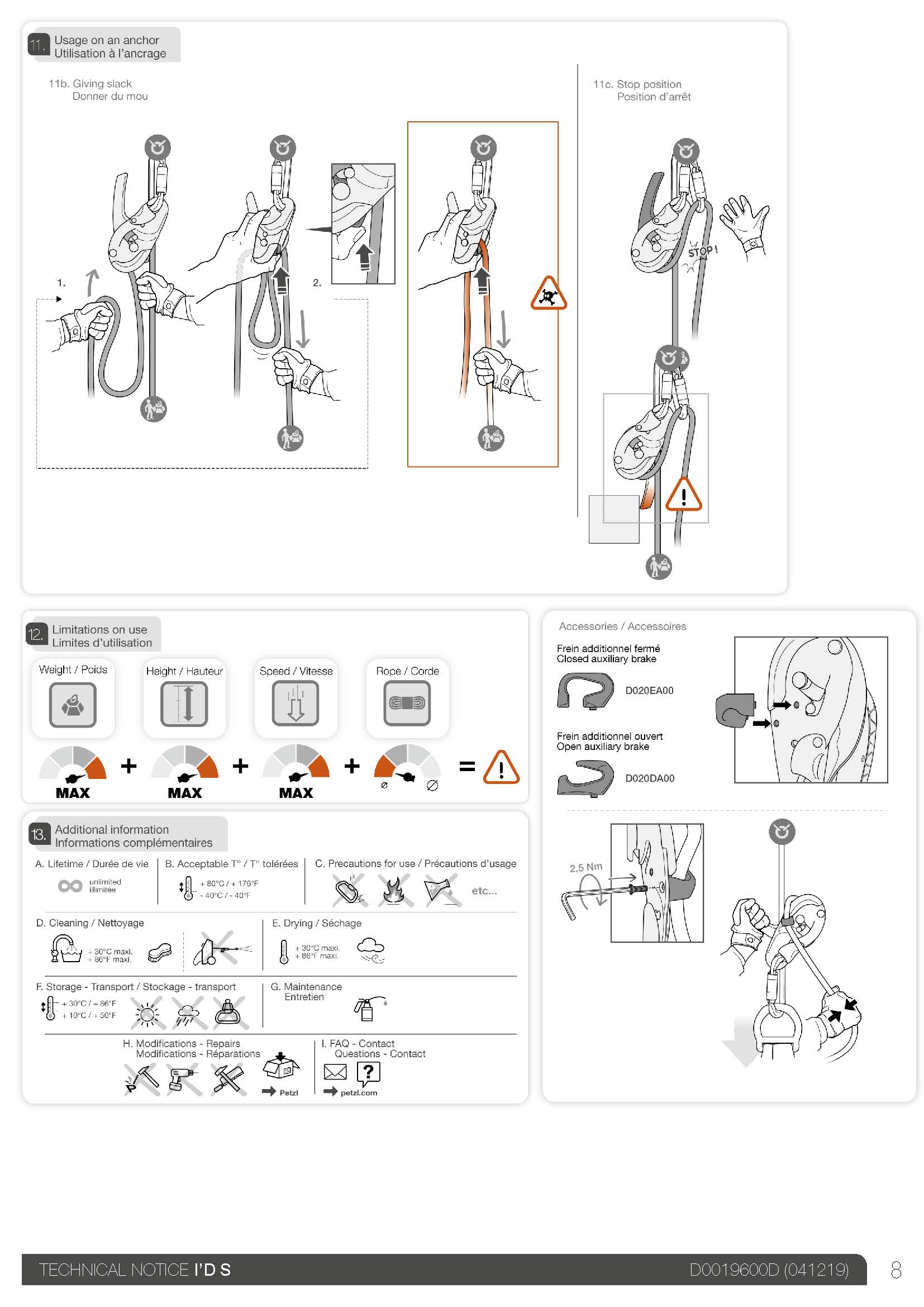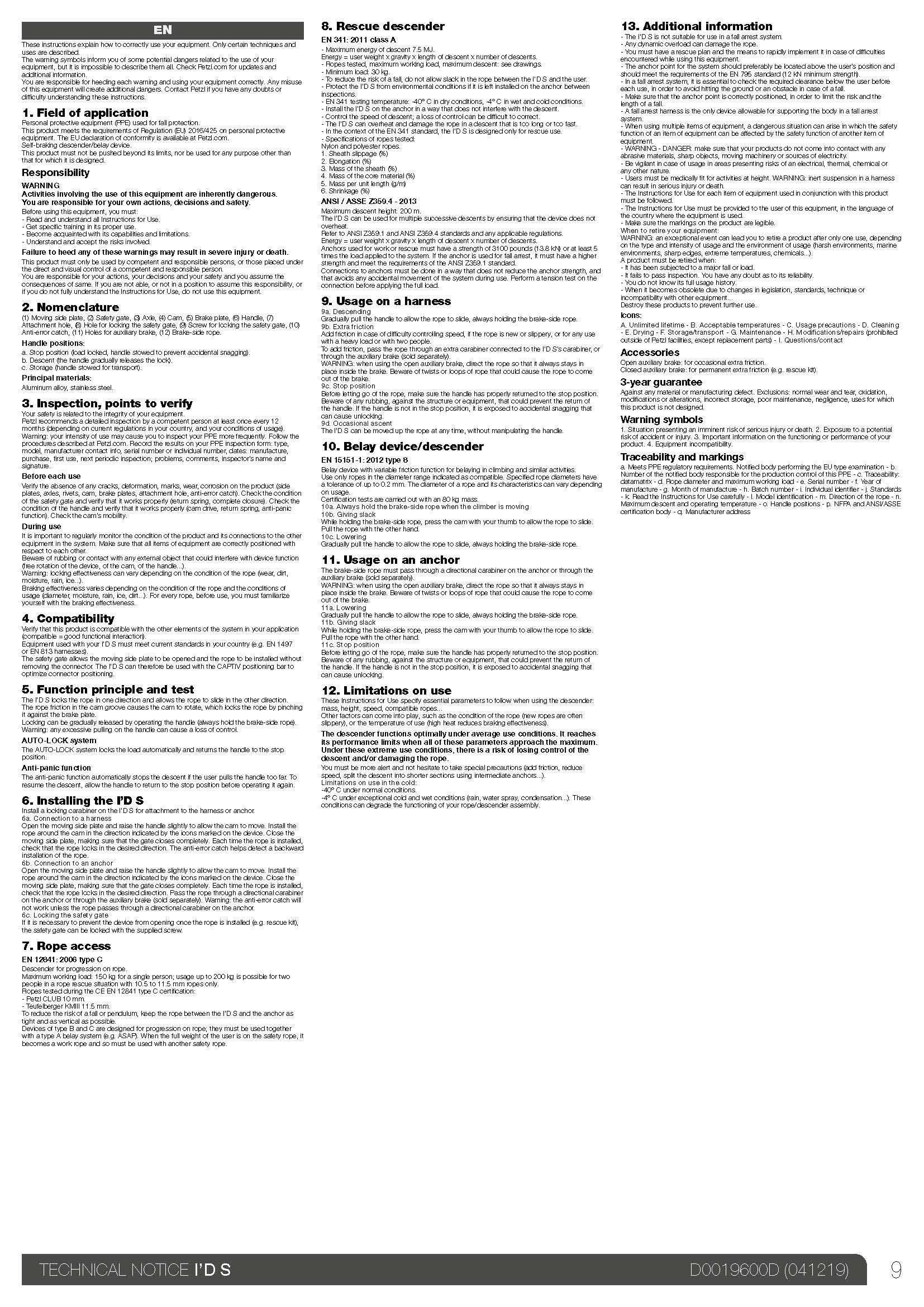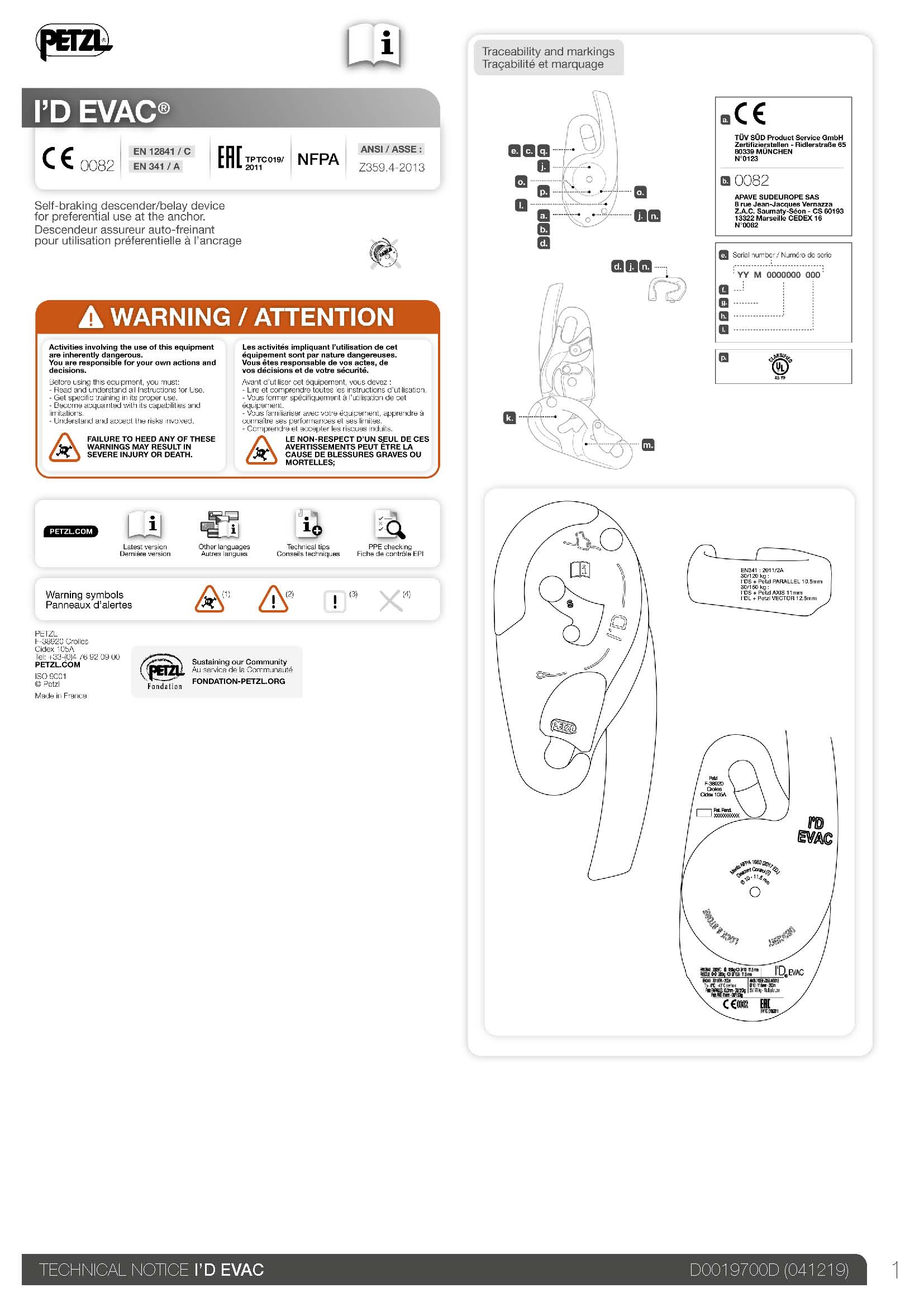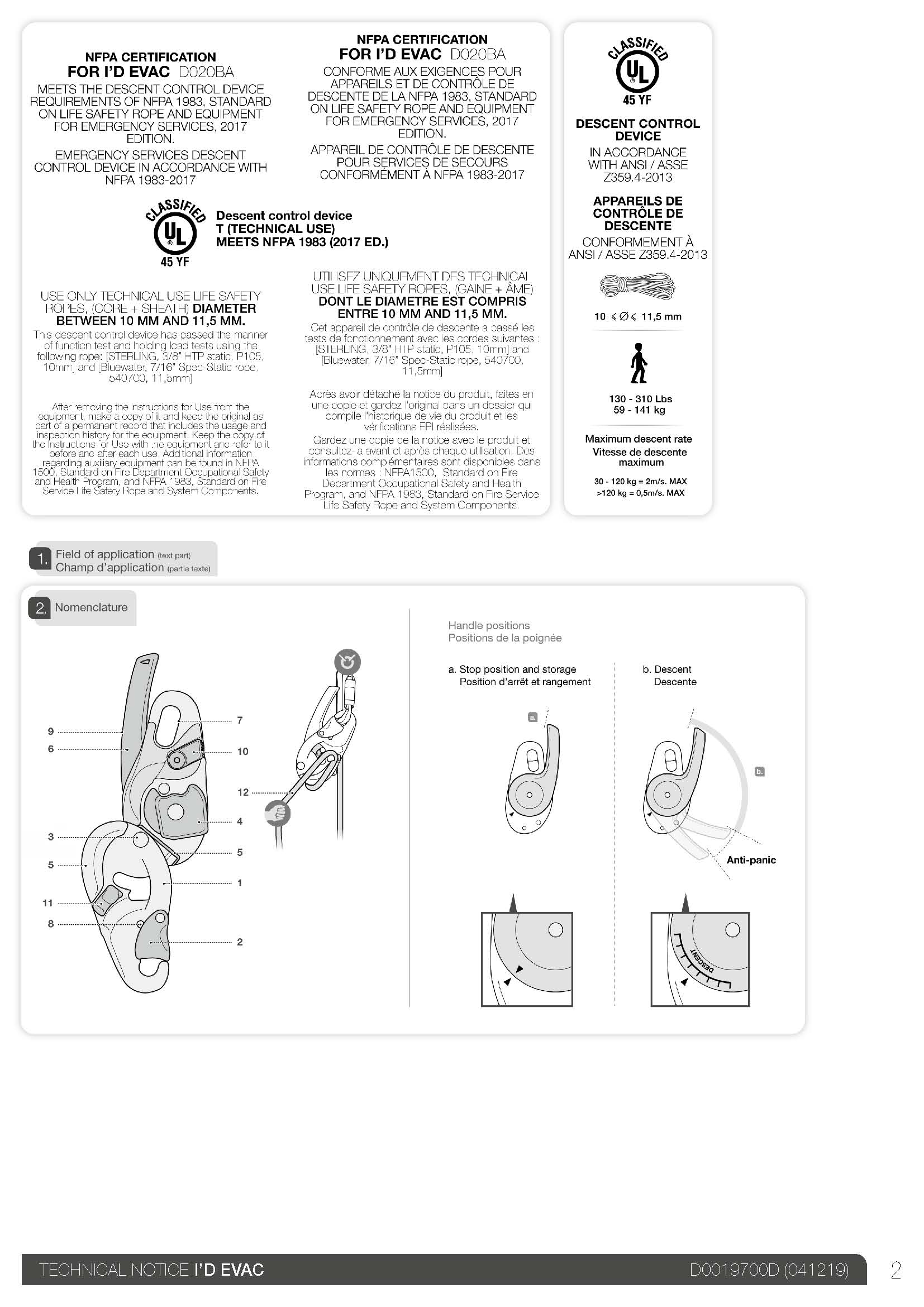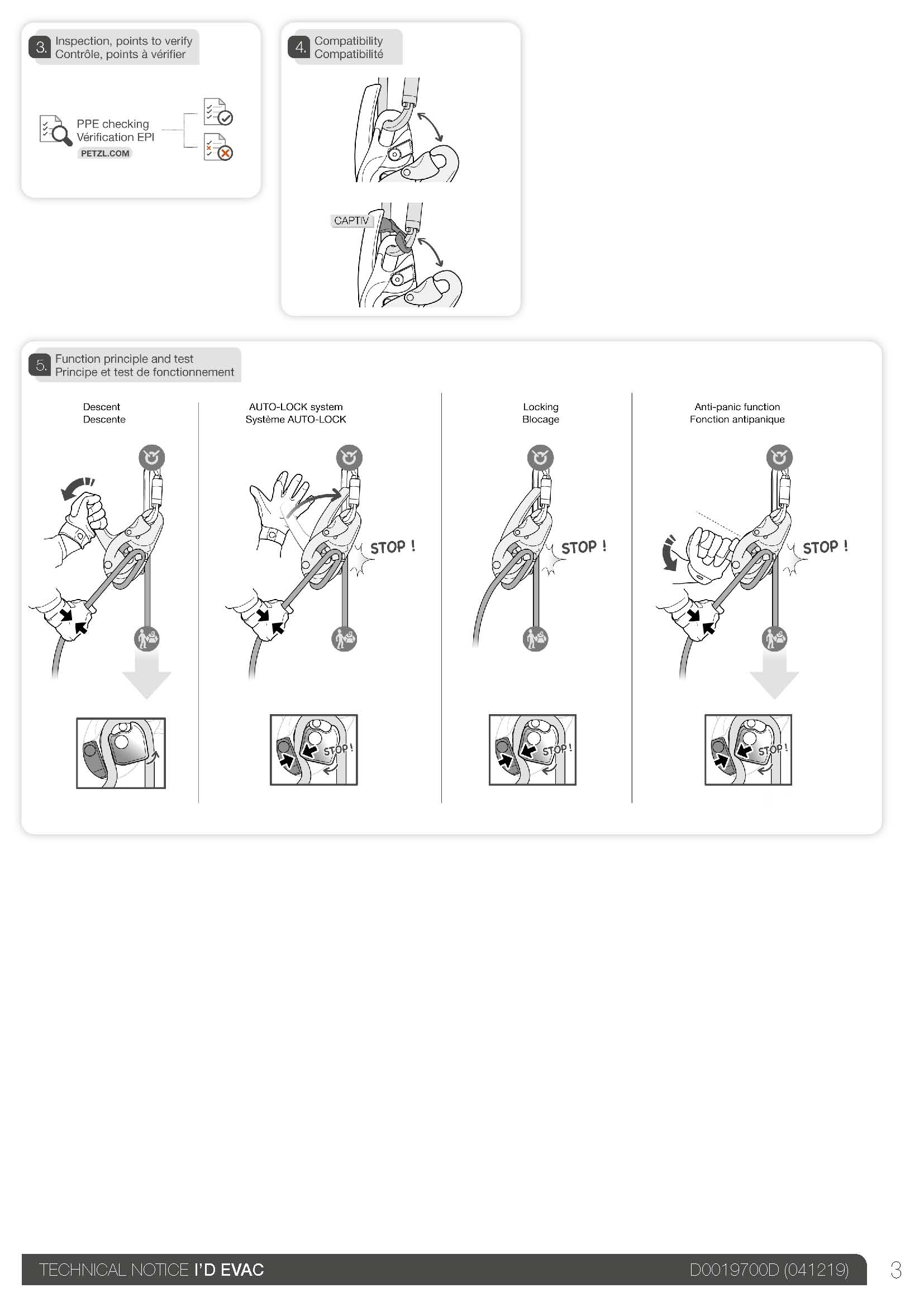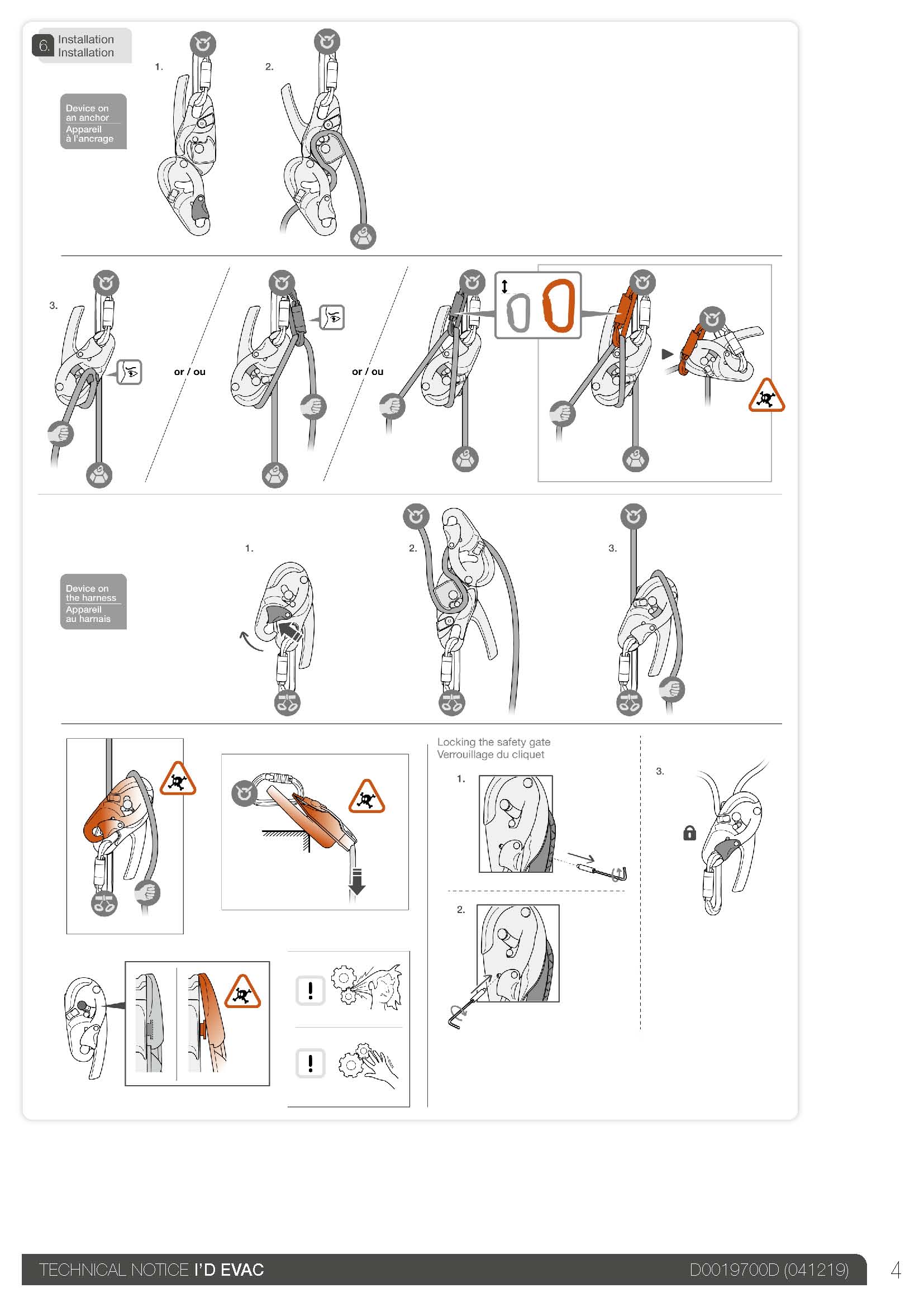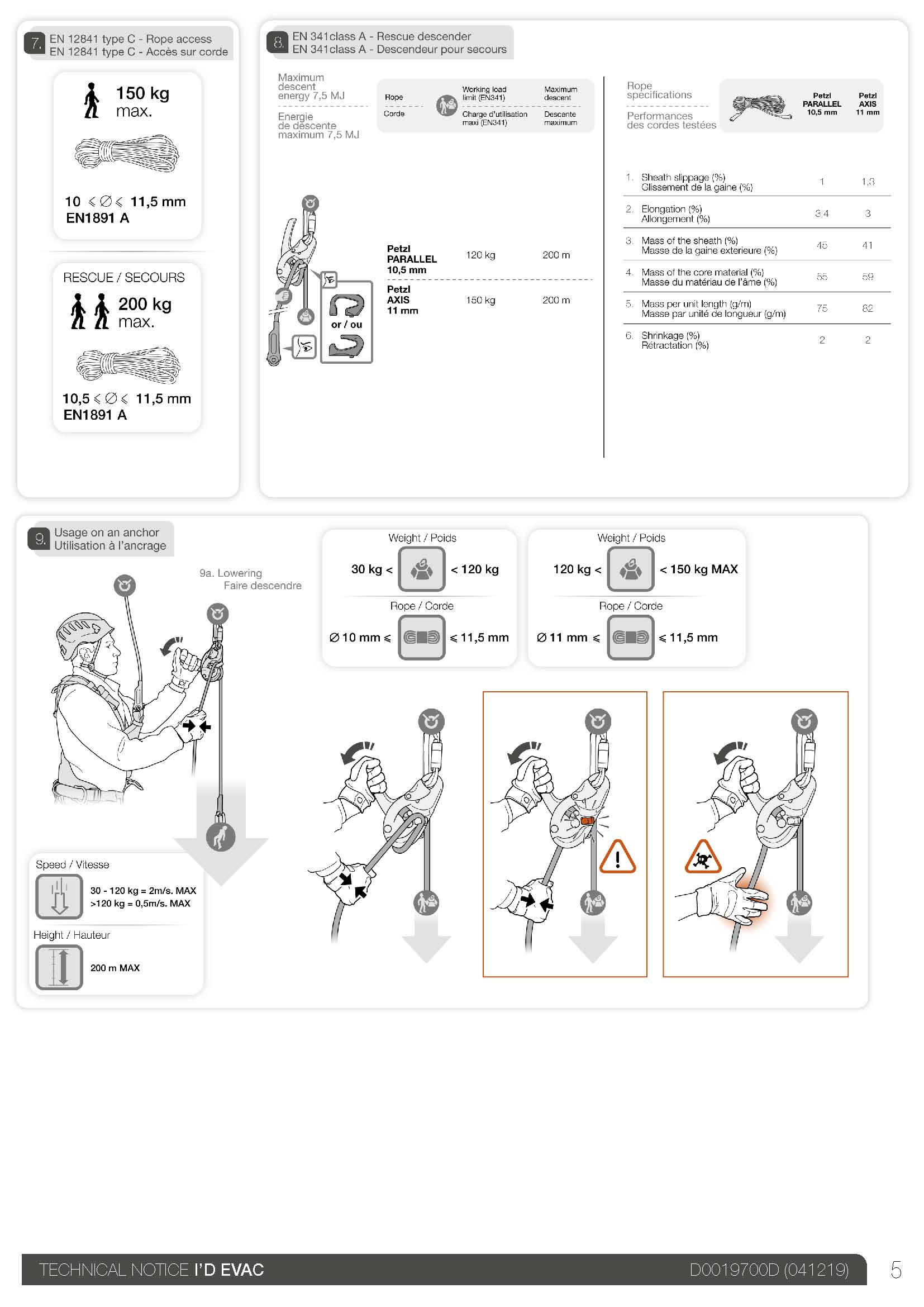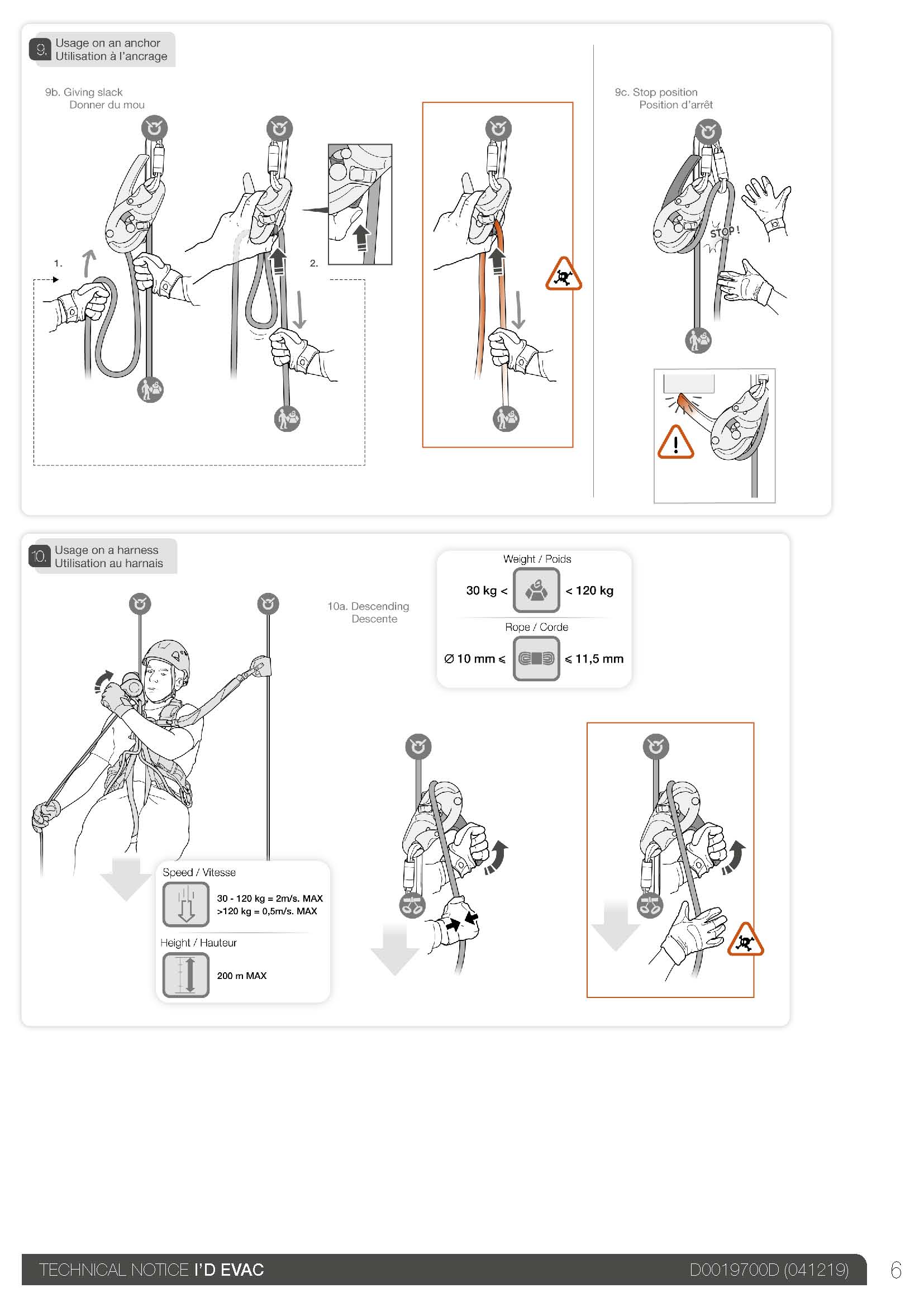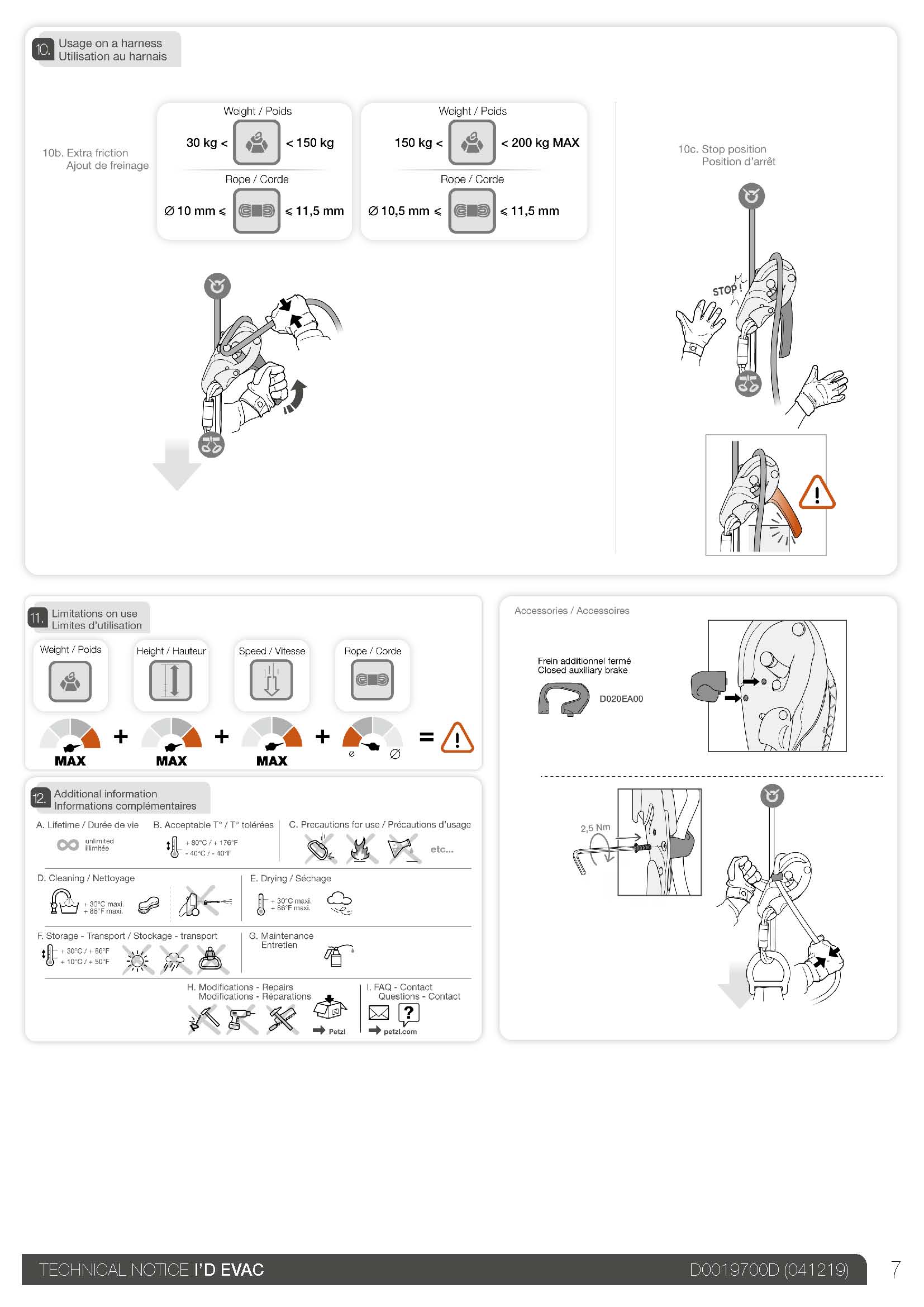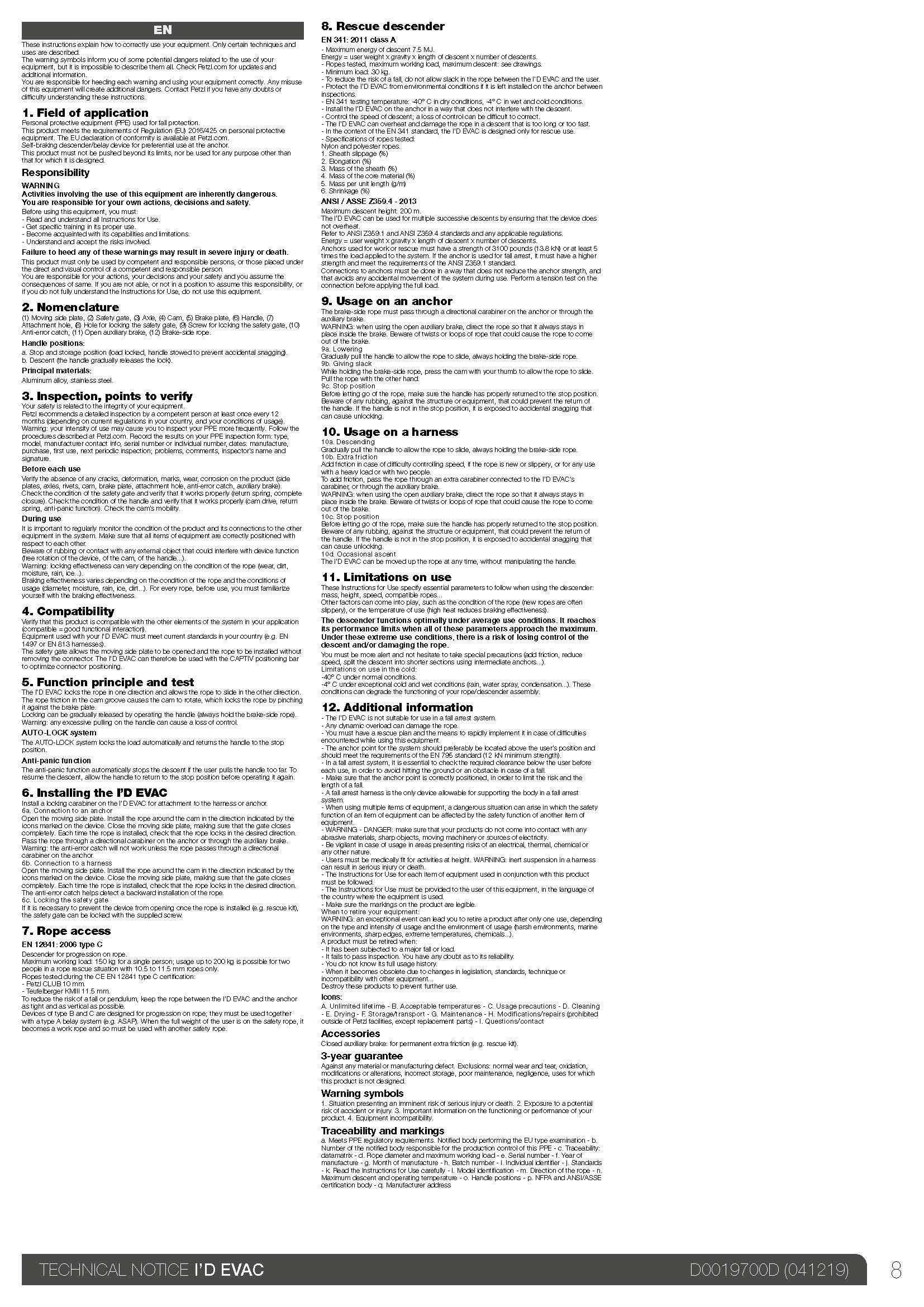Overview
Future History
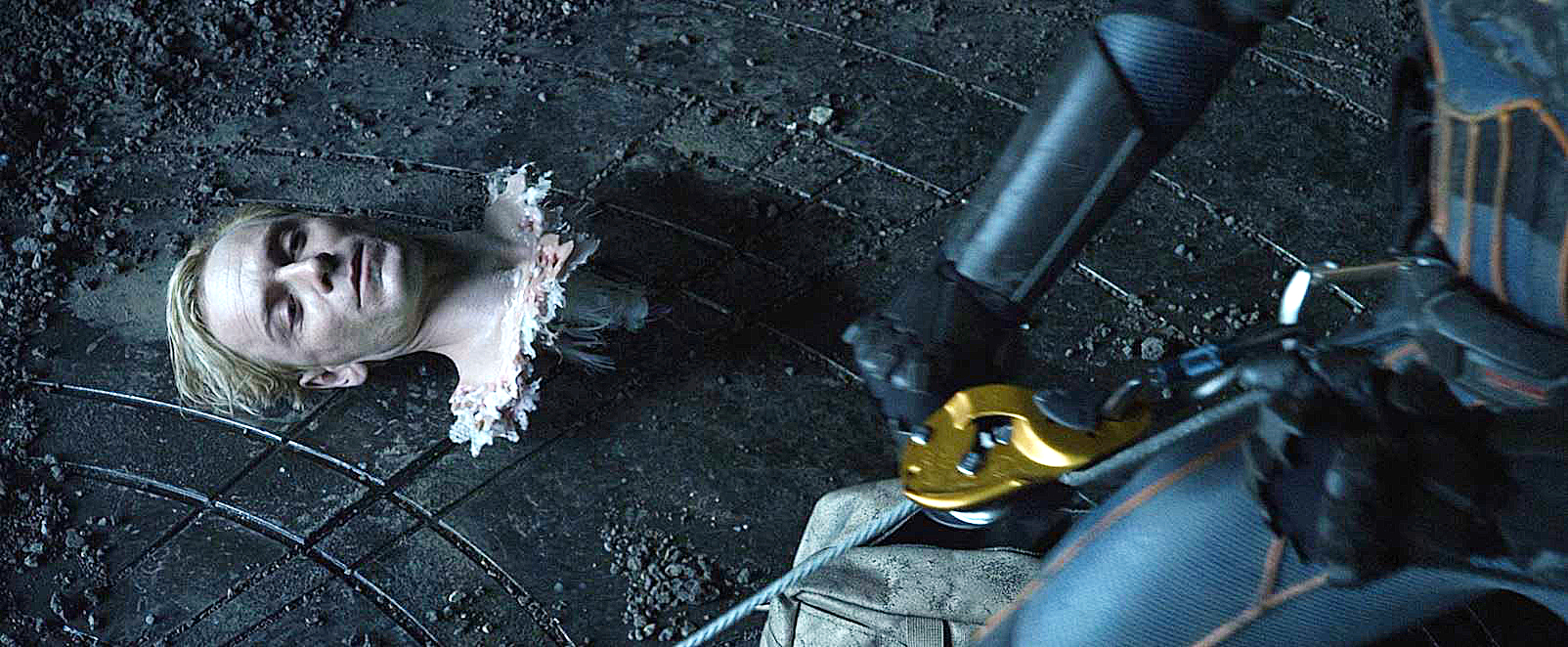
The Petzl I'D will still be in use in 2093 aboard the spaceship Prometheus [1]. My time-traveling friends noted that it was being used inverted, but this is because the I'D shown being used to lower a body from above.
[1] Ridley Scott (Dir.), 2012. "Prometheus." 20th Century Fox.
[ Top
| Large I’D v. B
| Large I’D v. C
| Large I’D v. D
| Large I’D v. D /w Closed Brake
| Large I’D v. D /w Open Brake
|
| Small I’D v. A
| Small I’D v. B
| Small I’D v. C
| Small I’D v. C /w Closed Brake
| Small I’D v. C /w Open Brake
|
| I’D Evac
| Return to Double-Stop Bobbins ]
Large I’D, Version A
(11.5-13 mm.)
(#565, 2433)
Technical Details
I acquired this I’D from Inner Mountain Outfitters in 2000. I acquired another in 2017 as part of Bob Thrun’s collection.
This I’D is 194 mm. tall, 83 mm. wide, 54 mm. thick, and
weighs 533 g.
The I’D is shaped like an inverted pear (or perhaps an avocado)
with a handle on the back. There are two stamped aluminum plates
with a variety of other parts attached. The rear plate is
black anodized 3 mm. aluminum, and serves as the main frame.
The lower portion of this plate is bent forward, and a 15 by 27.6
mm slot serves as the clip-in eye.
The rear plate has several components mounted on it. Starting
from the top, there is a 16 mm. thick rounded triangular
anvil mounted at the upper right. Below this to the left is a
60 mm. diameter bollard. Most of the bollard’s circumference
is grooved to guide the rope. The upper left side of the main
bollard is flattened so that the rope can run between it and the
anvil. The lower portion is cut away to clear a small post. The
main bollard can be rotated about 30 degrees using the handle.
Rotating the bollard clockwise squeezes the rope against the anvil,
stopping the descent.
The post is slightly grooved, being 12 mm. in diameter
at the ends and only 10 mm. in the center. Although the rope
runs over the post, its primary function is to limit the rotation
of the main bollard.
There is a small toothed cam (pattern (4.3)^2(3)^2(2)) beneath
the post. Petzl calls this the "anti-error catch." It
does not appear to serve any useful purpose when the I’D is rigged
correctly. The cam is asymmetric. Looking at the cam, the left
side is parallel to the vertical rear plate, but the right side
leans out about 4 mm. There is about an 8 mm. gap between
the cam and front plate, so the asymmetry is not needed for clearance.
Finally, a plastic guide runs down the right side of the I’D.
Its function is cosmetic.
The front plate is mounted and pivots on a small rivet attached
to the lower right corner of the anvil. The fit is quite loose.
This plate is stamped into a more complex form than the rear plate.
The left side is bent back on itself to create a rounded edge
for the rope to run against. The left side is raised so that it
clears a slot that engages a rim on the main bollard pivot. A
notch in the slot rests against the small bollard. A dimple in
the top hits the anvil; unlike similar dimples on Petzl ascenders,
this one actually makes contact. A J-notch on the lower portion
of the front plate lines up with the oval hole on the rear plate.
The notch admits the seat maillon, but the notch is longer so
all weight is carried on the rear plate. A plastic safety catch
keeps the front plate from accidentally opening, although the
shape of the notch would suffice as long as the I’D was weighted.
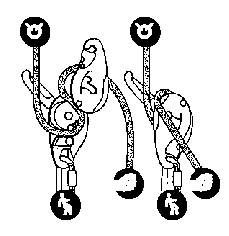 The
normal rigging path is to bring the rope down the left side, under
the main bollard and smaller bollard, and up between the main
bollard and the anvil, then out the top and over the anvil. The
rope path is much like the classic bobbin rope path.
The
normal rigging path is to bring the rope down the left side, under
the main bollard and smaller bollard, and up between the main
bollard and the anvil, then out the top and over the anvil. The
rope path is much like the classic bobbin rope path.
The main bollard is turned by the handle on the rear of the
device. The handle pivots on an extension of the front post, and
held on by a 40 mm. diameter aluminum fender washer. A clutch
assembly controls the motion. The clutch is not visible without
destroying the device. A light spring tends to turn the bollard
counter-clockwise, but when used on rope the rope friction completely
overpowers the spring. As a result, the behavior of the device
on rope is quite different than one would expect after examining
the device in the hand. The device works as follows: When viewed
from the front, the normal descending position is with the handle
at 9 o’clock. The rope friction is turning the bollard so that
the rope is squeezed against the anvil. Pulling down (counter clockwise)
on the handle turns the main bollard counterclockwise, which releases
the rope. If the handle is moved too far, the clutch slips and
the bollard rotates back to the locking position (clockwise).
Pulling the handle lower now turns the bollard clockwise, forcing
the rope against the anvil and increasing friction further, much
like power brakes.
Turning the handle from 9 o’clock to 1 o’clock does not affect
the bollard’s position. From this point, the handle moves in distinct
steps. The first one (to 2 o’clock) does not rotate the bollard,
but the next six steps (turning the handle to 6 o’clock) turn
the bollard clockwise, again increasing friction. The distinct
steps hold the handle in position. The bollard does not turn uniformly,
instead, each step yields progressively less motion.
The front plate is stamped with the Petzl Logo, "I’D,"
"MADE IN FRANCE," "PATENTED," a Reading-Is-Dangerous icon, and an illustration
of the device in use. The outside of the rear plate is stamped
"99147G," "CE0197," "EN 341 TYPE A,"
and "MAX 150 Kg /200m." The inside has symbols that
I believe are intended to show how the device is rigged. One symbol
looks like a shepherd’s crook, the other shows a hand holding
a rope. The main bollard has "Rope" and "11.5≤Ø≤13"
cast into it.
The large Petzl I’D is designed for 11.5 to 13 mm. rope.
The external dimensions are identical to the small I’D, and the
only easy ways to tell them apart are color (the small one is
golden) or by reading the cam casting. It appears that except for color, only the
main bollard is different. The large I’D has a smaller bollard than the small I’D, providing more clearance for
larger rope.
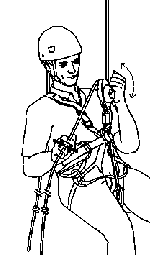 I'm not a fan of control handles, and the one on the I’D doesn't
impress me. The light plastic handle does not inspire confidence.
When the handle is in the normal rappelling position (9 o’clock)
one can stop by pushing the handle down, but I find it easier
to brake as one does with more traditional devices. Locking off
involves moving the handle toward 3 o’clock (or farther), but
if you need your hands free I recommend either tying off or clipping
an ascender on as a backup.
I'm not a fan of control handles, and the one on the I’D doesn't
impress me. The light plastic handle does not inspire confidence.
When the handle is in the normal rappelling position (9 o’clock)
one can stop by pushing the handle down, but I find it easier
to brake as one does with more traditional devices. Locking off
involves moving the handle toward 3 o’clock (or farther), but
if you need your hands free I recommend either tying off or clipping
an ascender on as a backup.
Rappelling
with the I’D was a surprise since the handle didn't work as I
had expected it to; instead, the I’D was locked off most of the
time. I tried the I’D on 12 mm. PMI, which is about the largest
rope that will fit into the small I’D (there is a larger version of
the I’D for the "bigger
is better" crowd). The I’D was completely locked for
all handle positions between 9 and 3 o’clock. Locking the handle
at 3 o’clock and then knocking it loose did not cause me to fall
to my death. This is one stop descender that I cannot rappel
on in the locked position, at least not on this rope. The only
way I could descend was to put the handle at 9 o’clock and then
pull down on it with my left hand. Building up speed was difficult
since pulling too far (and not very far at that) caused the clutch
to slip and the I’D would lock off. After a while (about 2 feet)
this began to annoy me, but with a little practice and a reserve
of patience, I was able to obtain a sustained descent.
The rope leaving the top of the I’D tends to run over the anvil
and remain in the plane of the bollard, tracing the traditional
bobbin "S" shape. At times it would slide out and run
over the edge of the front plate. At no time did it tend to run
over the rounded portion of the front plate as indicated by the
stamping on the plate.
When rigging the I’D, be careful to rig it high. I found that
if the I’D is rigged low, it is difficult to slide it up because
the anti-error catch will engage. The catch serves no useful purpose
that I know of except for interfering with the natural de-selection
of those who can't follow the cryptic rigging directions stamped
inside the device. Perhaps clearer icons (like an arrow) might
eliminate the need for the catch. In my case, most ropes that
I use hang vertically and exhibit cylindrical symmetry so the
asymmetry of the cam is of no real advantage.
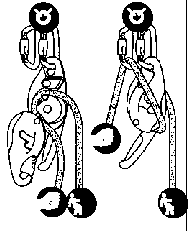 The eye slot is not large enough or shaped properly for using
redundant seat carabiners instead of the safer maillon rapide
links.
The eye slot is not large enough or shaped properly for using
redundant seat carabiners instead of the safer maillon rapide
links.
The I’D is stamped " "MAX 150 Kg /200m." which
clearly indicates that the I’D is not suitable for large persons
carrying heavy loads, nor is it suitable for long drops. Although
it is common for manufacturers to stamp strength figures into
their equipment, one generally does not see a depth limit. I have
to commend Petzl for mentioning this. Certainly this is not a
device for large persons and heavy loads, such as one finds in
expedition caving, big wall climbing, or some industrial settings.
It is also not a device for long drops.
The
ID can also be rigged for lowering. When doing so, use a second
carabiner to guide the braking end of the rope so that it follows
the complete S-shaped path.
The Petzl I’D is protected by U.S. Patents #5,360,083 and #5,577,576. These are worth reading if you
are interested in how the internal mechanism works.
Despite my first impressions, the I’D really isn't a bad device.
It apparently isn't strong enough for rescue use,
and I wouldn't want to expose the clutch to abrasive cave mud,
but it performs much better than I expected and it does provide
a relatively secure stop position. I'm still no fan of stop descenders
for a variety of reasons,
but this one is fun to play with.
[ Top
| Large I’D v. A
| Large I’D v. C
| Large I’D v. D
| Large I’D v. D /w Closed Brake
| Large I’D v. D /w Open Brake
|
| Small I’D v. A
| Small I’D v. B
| Small I’D v. C
| Small I’D v. C /w Closed Brake
| Small I’D v. C /w Open Brake
|
| I’D Evac
| Return to Double-Stop Bobbins ]
Large I’D, Version B
(Model D20L)
(#1166)
Technical Details
I acquired my Petzl I’D, D20L from Rescue Response Gear Inc. in
2008. It is 203 mm. tall, 79 mm. wide, 52 mm. thick., and weighs
525 g.
The front plate is stamped with the same markings as the small
I’D. The outside of the rear plate is printed with "08009FI 7036,"
and stamped "CE0197," "EN 341 TYPE A," and
"MAX 150 Kg /200m." The rear of the handle axle is marked
with "Meets NFPA 1983 (06Ed.)," MBS 22kN,"
"G," "CLASSIFIED," the Underwriters’ Laboratories
logo, and "45YF." The inside has the same obscure symbols
as the small ID. The main bollard has "Rope" and "10≤Ø≤11.5"
cast into it.
The D20L is similar to the large Petzl I’D, the primary difference
is that the D20L lacks the plastic safety gate. This makes the
D20L safer for some industrial applications, but makes it harder
to open the I’D during certain common caving maneuvers.
[ Top
| Large I’D v. A
| Large I’D v. B
| Large I’D v. D
| Large I’D v. D /w Closed Brake
| Large I’D v. D /w Open Brake
|
| Small I’D v. A
| Small I’D v. B
| Small I’D v. C
| Small I’D v. C /w Closed Brake
| Small I’D v. C /w Open Brake
|
| I’D Evac
| Return to Double-Stop Bobbins ]
Large I’D, Version C
(Model L)
(#1218, 2478†)
Technical Details
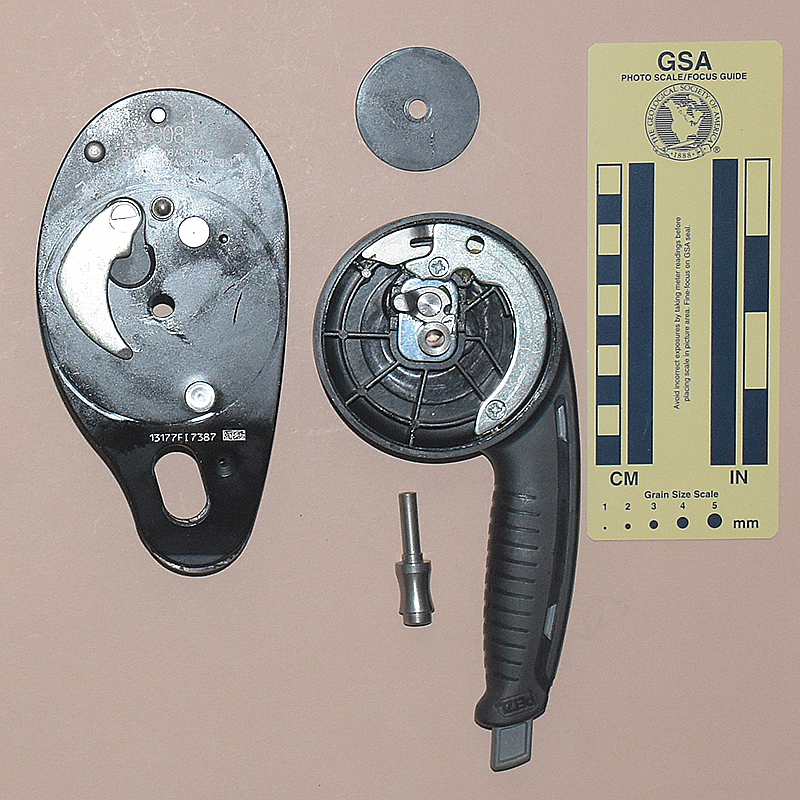 I acquired my Petzl I’D, Large Version C from On Rope 1 in 2009. I acquired a second one from Amanda DeSouza in 2017, and in 2021 cut it open to show the internal mechanism.
I acquired my Petzl I’D, Large Version C from On Rope 1 in 2009. I acquired a second one from Amanda DeSouza in 2017, and in 2021 cut it open to show the internal mechanism.
Large Version C is 212 mm. tall, 80 mm. wide, 54 mm. thick, and weighs 550 g. It differs from Large Version B in the same ways that Small Version B differs from Small Version A; specifically:
- Large Version C has a "horizontal movement button" at the end of the handle that disengages the panic brake feature.
- The anti-error catch has a different shape, sits lower, and has a (4.3)^3(4) tooth pattern.
- The plastic guide has a different shape, and its mounting screws are visible.
The markings on Large Version C are the same as those on Small Version A, with the following exceptions:
- On the back, "09028F T9093" replaces "09036F T0556."
- The scanner codes are different
- On the back, "G" replaces "L."
- There is no Petzl logo on the nonexistent safety.
Large Version C is a larger version of Small Version B. It lacks the safety catch found on the small version, and has a slightly smaller bollard sized for larger ropes.
[ Top
| Large I’D v. A
| Large I’D v. B
| Large I’D v. C
| Large I’D v. D /w Closed Brake
| Large I’D v. D /w Open Brake
|
| Small I’D v. A
| Small I’D v. B
| Small I’D v. C
| Small I’D v. C /w Closed Brake
| Small I’D v. C /w Open Brake
|
| I’D Evac
| Return to Double-Stop Bobbins ]
Large I’D, Version D
(Model L)
(#2524)
Technical Details
I acquired my Petzl I’D, Large (Model L), Version D from On Rope 1 at the 2019 NSS Convention.
This I’D is 200 mm. tall, 83 mm. wide, 56 mm. thick, and weighs 588 g. It differs from Large Version C in the same ways that Small Version C differs from Small Version B; specifically:
- Version C eliminates the "horizontal movement button."
- The turned rope-running surface at the top left was replaced by a stainless steel casting.
The markings on Large Version D are the same as those on Small Version C, with the following exceptions on he outside of the rear plate:
- The certifications are different:
- The EN12841 rope sizes are different. The rating now reads "EN12841: 2006/C •Ø12.5-13mm" on the first line and a man icon followed by ":150kg" then two man icons followed by ":200kg" on the second.
- The EN341 rating now only applies to one rope, reading "Petzl VECTOR 12,5mm - 30/120kg."
- The rope size for the ANSI rating is increased to "Ø12.5-13mm."
- The EN15151-1 ratings are not present.
- "I’D®L" replaces "I’D®s"
- " 19C0180559104" replaces "19B0178196038."
The "S" on the small version bollard is replaced by an "L" on the large version bollard.
Large Version D is a larger version of Small Version C.
[ Top
| Large I’D v. A
| Large I’D v. B
| Large I’D v. C
| Large I’D v. D
| Large I’D v. D /w Closed Brake
| Large I’D v. D /w Open Brake
|
| Small I’D v. A
| Small I’D v. B
| Small I’D v. C
| Small I’D v. C /w Open Brake
|
| I’D Evac
| Return to Double-Stop Bobbins ]
Large I’D, Version C (Model L)
/w Closed Brake
(#2592+2587)
Technical Details
I acquired this Petzl I’D, Large (Model L) from Lisa Seifert and the closed brake from KS Rescue, both in 2021.
With the closed brake attached, this I'D is 205 mm. tall, mm. wide, 56 mm. thick, and weighs 608 g.
I will not repeat the description of the Model L I'D descender here.
The closed brake kit kit D020EA00 adds a closed loop to provide additional braking. The kit consists of a steel brake loop and a countersunk machine screw to secure the brake to two holes in the main descender cover plate.
The loop is 19 mm. tall, 42 mm. wide, 26 mm. thick, and weighs 24 g. It increases the size and weight of the descender. For mine, the thickness increased from
56 mm. to 71 mm. and the weight from 584 to 608 g.
The brake loop is printed was follows:
EN341 : 2011/2A
30/120 kg - 200m - T>-40°C
I'DS + Petzl PARALLEL 10.5mm
30/150 kg - 200m - T>-40°C
I'DS + Petzl Axis 11mm
I'DL + Petzl VECTOR 12.5mm
Petzl offers two Additional Brake kits, the D020DA00 Open Additional Brake kit and the D020EA00 Closed Additional Brake kit.
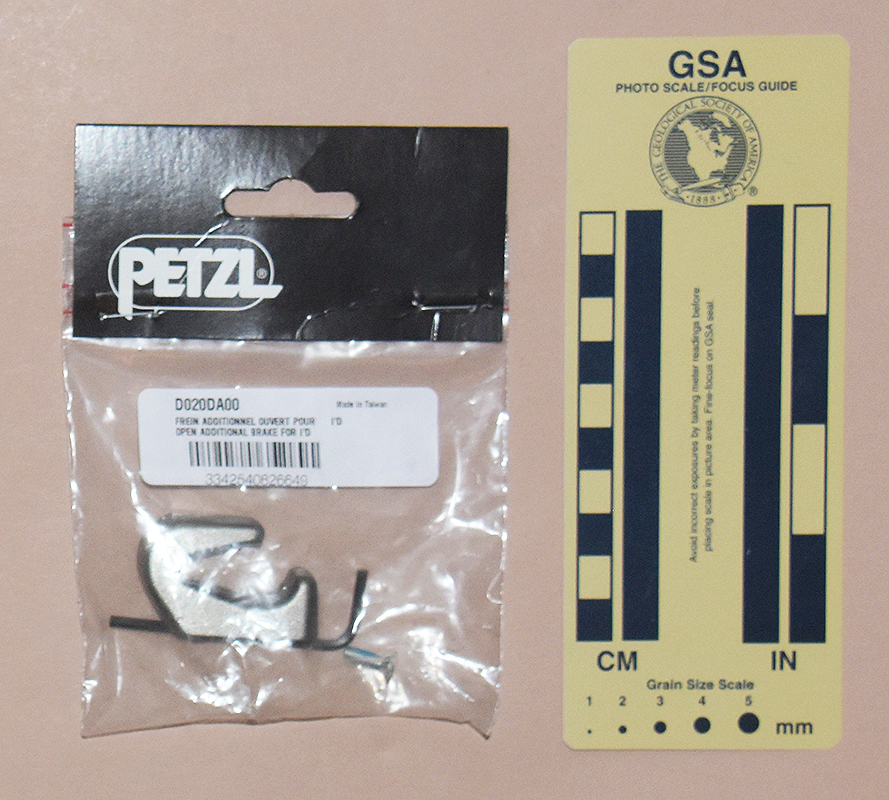 |
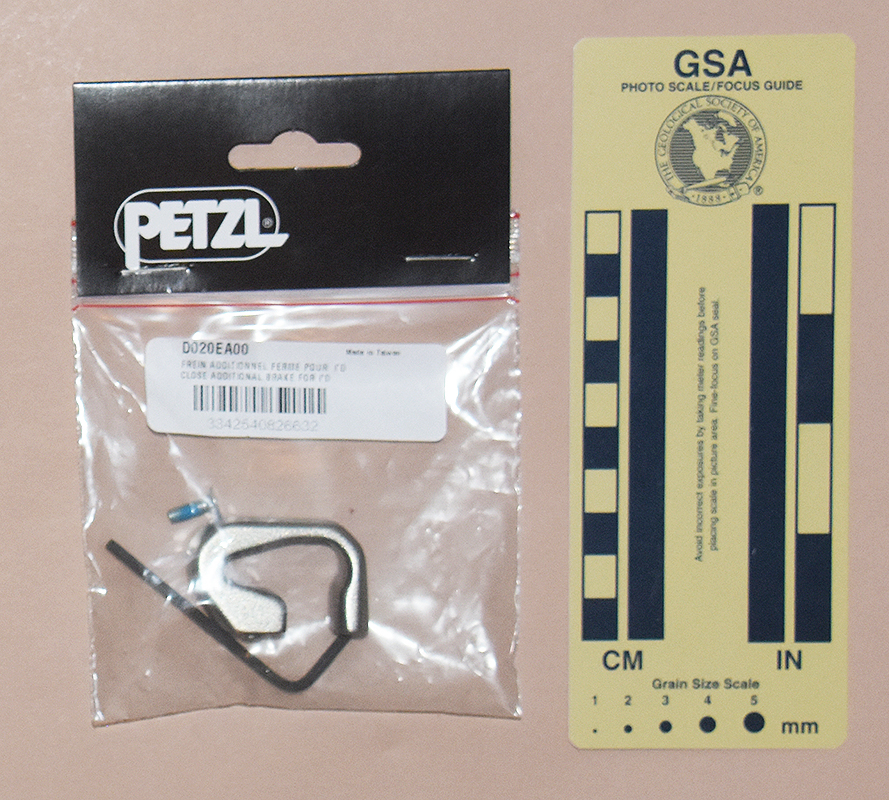 |
Open Brake
D020DA00 |
Closed Brake
D020EA00 |
Either kit can be added to a latest-version small (Model S) or large (Model L) I'D. Both kits have a V-shaped notch to provide additional friction.
The open brake allows the user to decide whether to use an equipped I'D as a standard I'D or employ the brake when additional braking is desirable, depending on the situation. The closed brake requires pre-rigging and reduces flexibility compared to the open brake, taking the choice away from a skilled user. Apparently it provides lawyer-mandated enhanced security for untrained or incompetent users - a scary thought, in my opinion.
The kits are intended for rescue lowering applications. I'll leave evaluation for that purpose to the INS crowd.
If the decision between the two is to to made by competent users, I would consider the open brake; but if it is to be made by the company lawyers, then the closed brake would probably get the nod. I do not see a need for either kit for normal rappelling applications, so my choice, for my purposes, is to leave it off.
[ Top
| Large I’D v. A
| Large I’D v. B
| Large I’D v. C
| Large I’D v. D
| Large I’D v. D /w Closed Brake
| Large I’D v. D /w Open Brake
|
| Small I’D v. A
| Small I’D v. B
| Small I’D v. C
| Small I’D v. C /w Closed Brake
|
| I’D Evac
| Return to Double-Stop Bobbins ]
Large I’D, Version C (Model L)
/w Open Brake
(#2589+2588)
Technical Details
I acquired this Petzl I’D, Large (Model L) from Mo Money Pawn and the open brake from Gear Express, both in 2021.
With the open brake attached, this I'D is 205 mm. tall, mm. wide, 56 mm. thick, and weighs 611 g.
I will not repeat the description of the Model L I'D descender here.
The open brake kit kit D020DA00 adds an open hook to provide additional braking. The kit consists of a steel brake hook and a countersunk machine screw to secure the brake to two holes in the main descender cover plate.
The hook is 17 mm. tall, 42 mm. wide, 26 mm. thick, and weighs 25 g. It increases the size and weight of the descender. For mine, the thickness increased from
56 mm. to 73 mm. and the weight from 586 to 611 g.
The brake hook is printed was follows:
EN341 : 2011/2A
30/120 kg - 200m - T>-40°C
I'DS + Petzl PARALLEL 10.5mm
30/150 kg - 200m - T>-40°C
I'DS + Petzl Axis 11mm
I'DL + Petzl VECTOR 12.5mm
Petzl offers two Additional Brake kits, the D020DA00 Open Additional Brake kit and the D020EA00 Closed Additional Brake kit.
 |
 |
Open Brake
D020DA00 |
Closed Brake
D020EA00 |
Either kit can be added to a latest-version small (Model S) or large (Model L) I'D. Both kits have a V-shaped notch to provide additional friction.
The open brake allows the user to decide whether to use an equipped I'D as a standard I'D or employ the brake when additional braking is desirable, depending on the situation. The closed brake requires pre-rigging and reduces flexibility compared to the open brake, taking the choice away from a skilled user. Apparently it provides lawyer-mandated enhanced security for untrained or incompetent users - a scary thought, in my opinion.
The kits are intended for rescue lowering applications. I'll leave evaluation for that purpose to the INS crowd.
If the decision between the two is to to made by competent users, I would consider the open brake; but if it is to be made by the company lawyers, then the closed brake would probably get the nod. I do not see a need for either kit for normal rappelling applications, so my choice, for my purposes, is to leave it off.
[ Top
| Large I’D v. A
| Large I’D v. B
| Large I’D v. C
| Large I’D v. D
| Large I’D v. D /w Closed Brake
| Large I’D v. D /w Open Brake
|
| Small I’D v. B
| Small I’D v. C
| Small I’D v. C /w Closed Brake
| Small I’D v. C /w Open Brake
|
| I’D Evac
| Return to Double-Stop Bobbins ]
Small I’D, Version A
(10-11.5 mm.)
(#556, 2433)
Technical Details
I acquired this I’D from Inner Mountain Outfitters in 1999. I acquired another in 2017 as part of Bob Thrun’s collection.
This I’D is 194 mm. tall, 83 mm. wide, 54 mm. thick, and
weighs 526 g.
It appears that except for color and marking details, the only apparent difference between small and large I’Ds of the same vintage is that the bollard on the small I’D is larger
than the bollard on the corresponding large I’D, providing less clearance and better locking action for
smaller rope.
The front plate is stamped with the Petzl Logo, "I’D,"
"MADE IN FRANCE," "PATENTED," a Reading-Is-Dangerous icon, and an illustration
of the device in use. The outside of the rear plate is stamped
"99176C," "CE0197," "EN 341 TYPE A,"
and "MAX 150 Kg /200m." The inside has symbols that
I believe are intended to show how the device is rigged. One symbol
looks like a shepherd’s crook, the other shows a hand holding
a rope. The main bollard has "Rope" and "10≤Ø≤11.5"
cast into it.
The main bollard has "Rope" and "10≤Ø≤11.5" cast into it.
The small Petzl I’D is designed for 10 to 11.5 mm. rope.
The external dimensions are identical to the large I’D, Version A, and the
only easy ways to tell them apart are color (the large one is
gray) or by reading the cam casting.
[ Top
| Large I’D v. A
| Large I’D v. B
| Large I’D v. C
| Large I’D v. D
| Large I’D v. D /w Closed Brake
| Large I’D v. D /w Open Brake
|
| Small I’D v. A
| Small I’D v. C
| Small I’D v. C /w Closed Brake
| Small I’D v. C /w Open Brake
|
| I’D Evac
| Return to Double-Stop Bobbins ]
Small I’D, Version B
(Model S)
(#1219, 2505†)
Technical Details
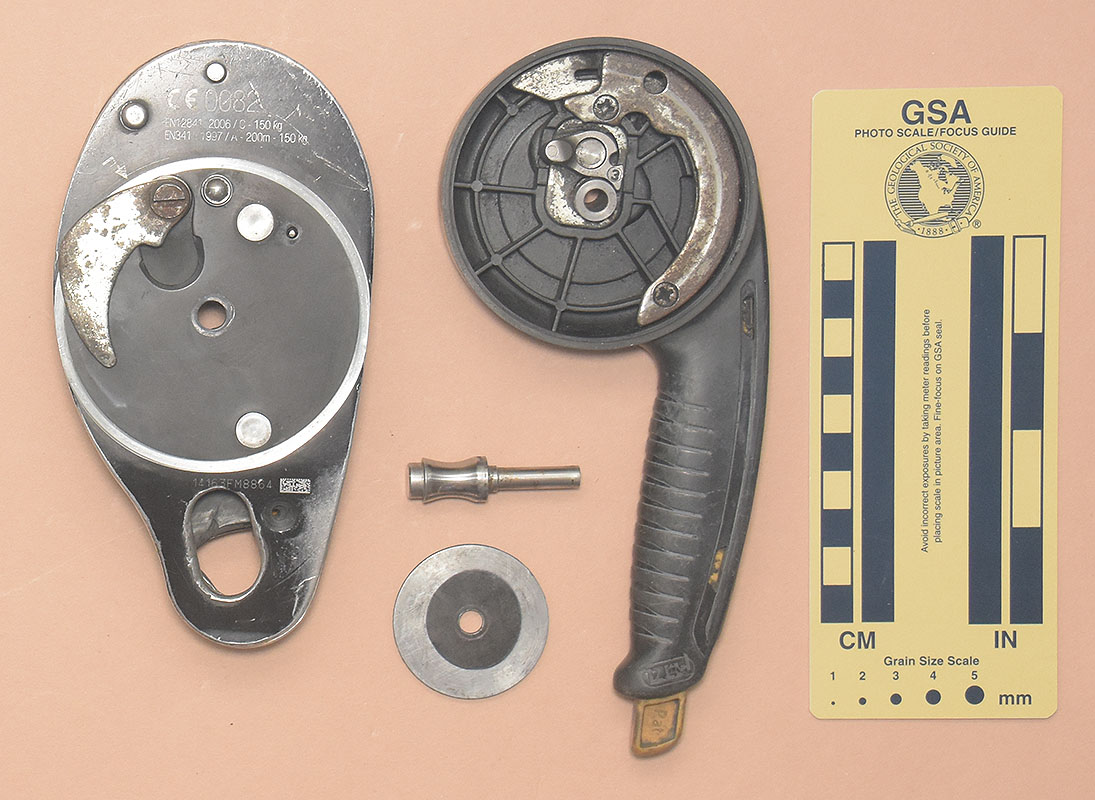 I acquired my Petzl I’D, Small Version B from On Rope 1 in 2009.
I acquired my Petzl I’D, Small Version B from On Rope 1 in 2009.
Small Version B is 212 mm. tall, 80 mm. wide, 54 mm. thick, and weighs 558 g. The main differences between Small Versions B and A are as follows:
- Version B has a "horizontal movement button" at the end of the handle that disengages the panic brake feature.
- The anti-error catch has a different shape, sits lower, and has a (3.2)^3(3) tooth pattern.
- The plastic guide has a different shape, and its mounting screws are visible.
The front plate is stamped with the Petzl Logo, "I’D,"
"MADE IN FRANCE," "PATENTED," a Reading-Is-Dangerous icon, and an illustration
of the device in use. The outside of the rear plate is printed with "CE0197," "EN12841: 2006/C-100 kg,"
"EN341 : 1997/A-200m - 150 kg," "09036F T0556", a scanner code, and a bent arrow pointing to the handle. The rear of the handle has molded range indicators opposite this arrow showing the following handle ranges: "LOCK," "STORE", "DESCENT," and "BELAY." The front and rear of the handle tip have molded Petzl logos. The plate at the rear center of the handle is marked with "MEETS NFPA 1003 (06 Ed.)," "MBS 14kN," "L," the Underwriters Laboratory "classified" logo, and "45YF." The inside has symbols that
I believe are intended to show how the device is rigged. One symbol
looks like a shepherd’s crook, the other shows a hand holding
a rope. The main bollard has "Rope" and "10≤Ø≤11.5"
cast into it. The anti-error catch has "Patented" cast into it. The front of the horizontal movement button has "Pat." in raised letters. The plastic safety catch has the Petzl Logo molded into it.
The "horizontal movement button" is designed to facilitate rappelling on "sloping or horizontal terrain" where the panic brake activates rather easily. The instructions warn against using the button on vertical descents.
[ Top
| Large I’D v. A
| Large I’D v. B
| Large I’D v. C
| Large I’D v. D
| Large I’D v. D /w Closed Brake
| Large I’D v. D /w Open Brake
|
| Small I’D v. A
| Small I’D v. B
| Small I’D v. C /w Closed Brake
| Small I’D v. C /w Open Brake
|
| I’D Evac
| Return to Double-Stop Bobbins ]
Small I’D, Version C
(Model S)
(#2523)
Technical Details
I acquired my Petzl I’D, Small (Model S), Version C from On Rope 1 at the 2019 NSS Convention.
This Petzl I’D is 202 mm. tall, 82 mm. wide, 59 mm. thick, and weighs 593 g. The main differences between Small Versions C and B are as follows:
- Version C eliminates the "horizontal movement button."
- The turned rope-running surface at the top left was replaced by a stainless steel casting.
The front plate is stamped with a hand holding a dashed line representing the rope, a Reading-Is-Dangerous icon, "I’D," and another dashed line representing the rope to the anchor.
The outside of the rear plate is printed with "CE0082," "EAC," "TP/TC 019/2011," "EN12841: 2006/C," a man icon followed by ":150kg•10-11.5 mm," "RESCUE followed by two man icons and then ":200kg•10.5-11.5 mm," "EN341 : 1997/A-200T>-40°C,", "Petzl PARALLEL 10,5-30/120kg," "Petzl AXIS 11mm-30/120kg," "ANSI/ASSE Z359.4/2013," "Ø10-11.5mm - 200m," :59/141kg - Multiple Use, "EN15151-1-2012/8," "Ø10-11mm," a triangle pointing toward the handle, "I’D®S", "Pat.Pend.," "19B0178196038," a scanner code, "Petzl," "F-38920," "Crolles," "and "Cidex 104A."
The rear of the handle has molded range indicators opposite the triangle showing the following handle ranges: "LOCK," "STORE", and "DESCENT." It also has "I’D" molded into it.
The plate at the rear center of the handle is marked with "MEETS NFPA 1003 (2017 Ed.)," "Descent Control Belay Device(T), "Ø 10-11.5mm," the Underwriters Laboratory "classified" logo, and "45YF." The inside has symbols that
I believe are intended to show how the device is rigged. One symbol
looks like a shepherd’s crook, the other shows a hand holding
a rope. The main bollard has the Petzl Logo and "S"
cast into it. The anti-error catch has "Patented" cast into it. The plastic safety catch has the Petzl Logo molded into it.
The "horizontal movement button" seemed like a silly idea to me. Apparently Petzl rethought the idea, and decided that it was not a desirable feature.
The stainless steel running surface should wear much better than the older design, which was merely a bend in the aluminum shell.
The marks on the front are confusing They are intended to be a rigging illustration; however, they do not show the rope running over the stainless steel edge and hence are are not accurate.
The extensive literary masterpiece printed on the rear is a result of the chaotic mess that the standards organizations have made. If I cannot make sense of all of this, I doubt that the average user can either. Reading carefully, they cannot even agree whether to use a period or a comma to separate integers from decimal fractions. Fortunately, none of this is of any value except to the lawyers, and for them, it merely serves as a substitute for reality. This isn't Petzl’s fault, it is our society’s fault.
[ Top
| Large I’D v. A
| Large I’D v. B
| Large I’D v. C
| Large I’D v. D
| Large I’D v. D /w Closed Brake
| Large I’D v. D /w Open Brake
|
| Small I’D v. A
| Small I’D v. B
| Small I’D v. C
| Small I’D v. C /w Open Brake
|
| I’D Evac
| Return to Double-Stop Bobbins ]
Small I’D, Version C (Model S)
/w Closed Brake
(#2565+2548)
Technical Details
I acquired this Petzl I’D, Small (Model S), Version C from Nicholas Harris in 2020, and Petzl’s Closed Additional Brake from Rock N Rescue in 2019.
With the open brake attached, this I'D is 202 mm. tall, mm. wide, 59 mm. thick, and weighs 616 g.
I will not repeat the description of the Model S I'D descender here.
The open brake kit kit D020DA00 adds an open hook to provide additional braking. The kit consists of a steel brake hook and a countersunk machine screw to secure the brake to two holes in the main descender cover plate.
The hook is 17 mm. tall, 42 mm. wide, 26 mm. thick, and weighs 25 g. It increases the size and weight of the descender. For mine, the thickness increased from
59 mm. to 72 mm. and the weight from 591 to 616 g.
The brake hook is printed was follows:
EN341 : 2011/2A
30/120 kg - 200m - T>-40°C
I'DS + Petzl PARALLEL 10.5mm
30/150 kg - 200m - T>-40°C
I'DS + Petzl Axis 11mm
I'DL + Petzl VECTOR 12.5mm
Petzl offers two Additional Brake kits, the D020DA00 Open Additional Brake kit and the D020EA00 Closed Additional Brake kit.
 |
 |
Open Brake
D020DA00 |
Closed Brake
D020EA00 |
Either kit can be added to a latest-version small (Model S) or large (Model L) I'D. Both kits have a V-shaped notch to provide additional friction.
The open brake allows the user to decide whether to use an equipped I'D as a standard I'D or employ the brake when additional braking is desirable, depending on the situation. The closed brake requires pre-rigging and reduces flexibility compared to the open brake, taking the choice away from a skilled user. Apparently it provides lawyer-mandated enhanced security for untrained or incompetent users - a scary thought, in my opinion.
The kits are intended for rescue lowering applications. I'll leave evaluation for that purpose to the INS crowd.
If the decision between the two is to to made by competent users, I would consider the open brake; but if it is to be made by the company lawyers, then the closed brake would probably get the nod. I do not see a need for either kit for normal rappelling applications, so my choice, for my purposes, is to leave it off.
[ Top
| Large I’D v. A
| Large I’D v. B
| Large I’D v. C
| Large I’D v. D
| Large I’D v. D /w Closed Brake
| Large I’D v. D /w Open Brake
|
| Small I’D v. A
| Small I’D v. B
| Small I’D v. C
| Small I’D v. C /w Closed Brake
|
| I’D Evac
| Return to Double-Stop Bobbins ]
Small I’D, Version C (Model S)
/w Open Brake
(#2569+2542)
Technical Details
I acquired this Petzl I’D, Small (Model S), Version C from Angie Beck in 2020, and Petzl’s Open Additional Brake from Amazon.com in 2019.
With the open brake attached, this I'D is 203 mm. tall, mm. wide, 59 mm. thick, and weighs 617 g.
I will not repeat the description of the Model S I'D descender here.
The open brake kit kit D020DA00 adds an open hook to provide additional braking. The kit consists of a steel brake hook and a countersunk machine screw to secure the brake to two holes in the main descender cover plate.
The hook is 17 mm. tall, 42 mm. wide, 26 mm. thick, and weighs 25 g. It increases the size and weight of the descender. For mine, the thickness increased from
59 mm. to 73 mm. and the weight from 592 to 617 g.
The brake hook is printed was follows:
EN341 : 2011/2A
30/120 kg - 200m - T>-40°C
I'DS + Petzl PARALLEL 10.5mm
30/150 kg - 200m - T>-40°C
I'DS + Petzl Axis 11mm
I'DL + Petzl VECTOR 12.5mm
Petzl offers two Additional Brake kits, the D020DA00 Open Additional Brake kit and the D020EA00 Closed Additional Brake kit.
 |
 |
Open Brake
D020DA00 |
Closed Brake
D020EA00 |
Either kit can be added to a latest-version small (Model S) or large (Model L) I'D. Both kits have a V-shaped notch to provide additional friction.
The open brake allows the user to decide whether to use an equipped I'D as a standard I'D or employ the brake when additional braking is desirable, depending on the situation. The closed brake requires pre-rigging and reduces flexibility compared to the open brake, taking the choice away from a skilled user. Apparently it provides lawyer-mandated enhanced security for untrained or incompetent users - a scary thought, in my opinion.
The kits are intended for rescue lowering applications. I'll leave evaluation for that purpose to the INS crowd.
If the decision between the two is to to made by competent users, I would consider the open brake; but if it is to be made by the company lawyers, then the closed brake would probably get the nod. I do not see a need for either kit for normal rappelling applications, so my choice, for my purposes, is to leave it off.
Adding the D020DA00 to a Model S essentially creates a Petzl Evac.
[ Top
| Large I’D v. A
| Large I’D v. B
| Large I’D v. C
| Large I’D v. D
| Large I’D v. D /w Closed Brake
| Large I’D v. D /w Open Brake
|
| Small I’D v. A
| Small I’D v. B
| Small I’D v. C
| Small I’D v. C /w Closed Brake
| Small I’D v. C /w Open Brake
|
| Return to Double-Stop Bobbins ]
I’D Evac
(#2525)
Technical Details
I acquired my Petzl I’D Evac from The Safe Path on Amazon.com in 2019.
My Petzl I’D Evac is 203 mm. tall, 83 mm. wide, 73 mm. thick, and weighs 616 g.
My I’D Evac is similar to my Small I’D, Version C, with the following differences:
- The I’D Evac has a cast stainless steel hook attached to the front plate with a single 4 mm. screw. A post on the hook engages a second hole in the plate, preventing rotation.
- There are internal differences in the handle function. Viewed from the rear with the catch down, the I’D Evac has a"Lock & Store" position with the handle at 6 o’clock and descent control with increasing friction as the the handle moves from 9 to 10 o’clock. There is no over-travel anti-panic function.
The markings on the rear of the I’D Evac are the same as those on Small Version C, with the following exceptions:
- The markings are inverted and repositioned, reflecting the I’D Evac’s use as a lowering device.
- On the back, "19C0181537955" replaces "19B0178196038."
- The scanner codes are different
- "I’D®EVAC" replaces "I’D®S."
The rear of the handle has molded range indicators opposite the triangle showing the following handle ranges: "LOCK&STORE", and "DESCENT." It also has "I’D EVAC" molded into it.
The hook on the I’D Evac is printed as follows:
EN341 : 2011/2A
30/120 kg - 200m - T>-40°C
I’DS + Petzl PARALLEL 10.5mm
30/150 kg - 200m - T>-40°C
I’DS + Petzl Axis 11mm
I’DL + Petzl VECTOR 12.5mm
The I’D Evac is designed as a lowering device and not as a descender. I included it here because of its obvious similarity to the I’D. It is possible to rappel on the Evac, but I do not recommend doing so. As for its rescue applications, I'll leave that evaluation to the INS crowd.
The markings on the hook referring to the small and large I’D are confusing.
As of this writing, Petzl does not list an I’D Evac sized for the 12.5-13 mm. battleship mooring hawsers preferred by the "Bigger is Better" crowd, but they sell the hooks separately so that one can add one to a standard small or large I’D. I don't see a reason to do this, since the hook alone does not change the handle function for lowering, and the hook is not needed for rappelling. Perhaps the INS crown feels differently; I'll leave that evaluation to them.
[ Top
| Large I’D v. A
| Large I’D v. B
| Large I’D v. C
| Large I’D v. D
| Large I’D v. D /w Closed Brake
| Large I’D v. D /w Open Brake
|
| Small I’D v. A
| Small I’D v. B
| Small I’D v. C
| Small I’D v. C /w Closed Brake
| Small I’D v. C /w Open Brake
|
| I’D Evac
]



 The
normal rigging path is to bring the rope down the left side, under
the main bollard and smaller bollard, and up between the main
bollard and the anvil, then out the top and over the anvil. The
rope path is much like the classic bobbin rope path.
The
normal rigging path is to bring the rope down the left side, under
the main bollard and smaller bollard, and up between the main
bollard and the anvil, then out the top and over the anvil. The
rope path is much like the classic bobbin rope path. I'm not a fan of control handles, and the one on the I’D doesn't
impress me. The light plastic handle does not inspire confidence.
When the handle is in the normal rappelling position (9 o’clock)
one can stop by pushing the handle down, but I find it easier
to brake as one does with more traditional devices. Locking off
involves moving the handle toward 3 o’clock (or farther), but
if you need your hands free I recommend either tying off or clipping
an ascender on as a backup.
I'm not a fan of control handles, and the one on the I’D doesn't
impress me. The light plastic handle does not inspire confidence.
When the handle is in the normal rappelling position (9 o’clock)
one can stop by pushing the handle down, but I find it easier
to brake as one does with more traditional devices. Locking off
involves moving the handle toward 3 o’clock (or farther), but
if you need your hands free I recommend either tying off or clipping
an ascender on as a backup. The eye slot is not large enough or shaped properly for using
redundant seat carabiners instead of the safer maillon rapide
links.
The eye slot is not large enough or shaped properly for using
redundant seat carabiners instead of the safer maillon rapide
links.